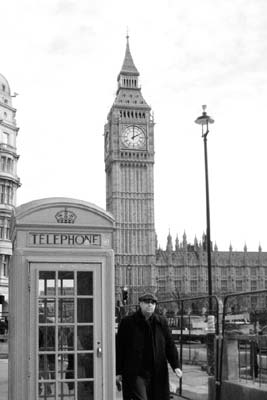
ST. PAUL’S CATHEDRAL AND NEARBY
Map: The City, The Tower & East London
These sights are arranged by neighborhood for handy sightseeing. When you see a  in a listing, it means the sight is covered in much more depth in a self-guided walk or self-guided tour. A
in a listing, it means the sight is covered in much more depth in a self-guided walk or self-guided tour. A  means the walk or tour is available as a free audio tour (via my Rick Steves Audio Europe app—see here
). Some walks and tours are available in both formats—take your pick.
means the walk or tour is available as a free audio tour (via my Rick Steves Audio Europe app—see here
). Some walks and tours are available in both formats—take your pick.
Check www.ricksteves.com/update for any significant changes that have occurred since this book was published. For money-saving tips, see “Affording London’s Sights” on here .
“Voluntary Donations”: Some London sights automatically add a “voluntary donation” of about 10 percent to their admission fees. The prices posted and quoted in this book include the donation, though it’s perfectly fine to pay the base price without the donation. Some of London’s free museums also ask for donations as you enter, but again, it’s completely optional.
These sights are listed in roughly geographical order from Westminster Abbey to Trafalgar Square, and are linked in the  Westminster Walk chapter and the
Westminster Walk chapter and the  free Westminster Walk audio tour.
free Westminster Walk audio tour.
The greatest church in the English-speaking world, Westminster Abbey is the place where England’s kings and queens have been crowned and buried since 1066. Like a stony refugee camp huddled outside St. Peter’s Pearly Gates, Westminster Abbey has many stories to tell. The steep admission includes a fine audioguide, worthwhile if you have the time and interest. To experience the church more vividly, take a live tour, or attend evensong or an organ concert.
Cost and Hours: £20, £40 family ticket (covers 2 adults and 1 child), includes cloister and audioguide; Mon-Fri 9:30-16:30, Wed until 19:00 (main church only), Sat 9:30-14:30, last entry one hour before closing, closed Sun to sightseers but open for services, guided tours available; cloister—daily 8:00-18:00; Tube: Westminster or St. James’s Park, tel. 020/7222-5152, www.westminster-abbey.org .
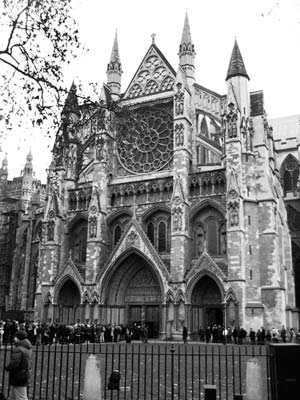
Music: The church hosts evensong performances daily except Wednesday, when it’s spoken instead of sung (Mon-Sat at 17:00 except Sept-April Sat at 15:00, Sun year-round at 15:00). A free 30-minute organ recital is usually held on Sunday at 17:45.
 See the Westminster Abbey Tour chapter.
See the Westminster Abbey Tour chapter.
This Neo-Gothic icon of London, the site of the royal residence from 1042 to 1547, is now the meeting place of the legislative branch of government. Like the US Capitol in Washington, DC, the complex is open to visitors. You can gain access one of two ways. While Parliament is in session, wait in line to enter for free and watch debates in one or both of the public galleries (either the bickering House of Commons or the sleepy House of Lords). Or reserve a tour of the historic building held on Saturdays year-round, and also on weekdays during parliamentary recess (generally late July-Sept) via audioguide or organized group.
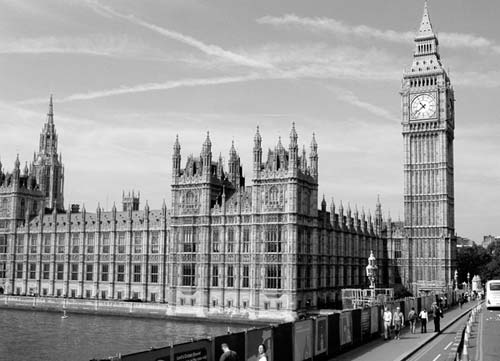
Whichever you choose, your visit will include the cavernous and historic Westminster Hall, St. Stephen’s Hall, and the Central Lobby—each impressive in its own right.
Cost and Hours (Public Galleries): Free, open only when Parliament is in session; House of Commons—Oct-late July Mon 14:30-22:30, Tue-Wed 11:30-19:30, Thu 9:30-17:30; House of Lords—Oct-late July Mon-Tue 14:30-22:00, Wed 15:00-22:00, Thu 11:00-19:30; last entry depends on the debates; exact schedule at www.parliament.uk .
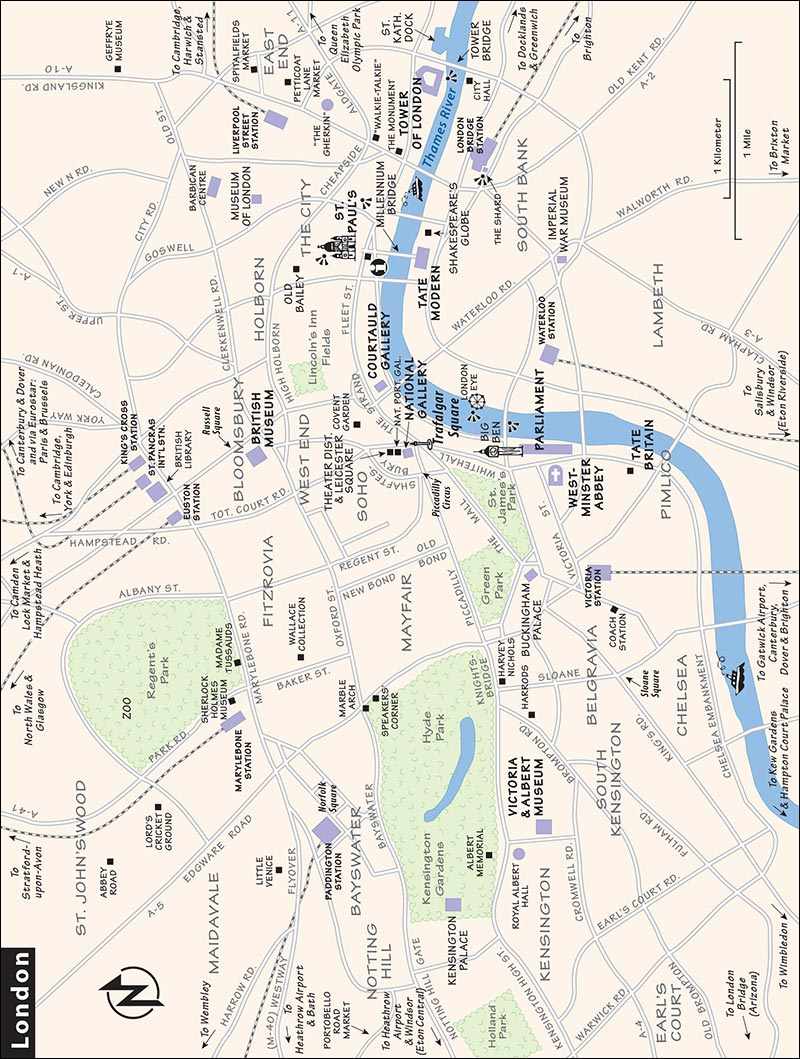
Tours: Audioguide-£18.50, guided tour-£25.50, Saturdays year-round 9:00-16:30 and most weekdays during recess (late July-Sept), 1.5 hours. Confirm the tour schedule and book ahead online at www.parliament.uk or by calling 020/7219-4114. The ticket office also sells tour tickets, but there’s no guarantee there will be same-day spaces available (open weekdays 10:00-16:00, Sat 9:00-16:30, closed Sun, located in Portcullis House, entrance on Victoria Embankment).
Crowd-Beating Tips: For the public galleries, lines tend to be longest at the start of each session, particularly on Wednesdays; for the shortest wait, try to show up later in the afternoon (but don’t push it, as things sometimes close down early).
 See the Houses of Parliament Tour chapter.
See the Houses of Parliament Tour chapter.
Nearby: Across the street from the Parliament building’s St. Stephen’s Gate, the Jewel Tower is a rare remnant of the old Palace of Westminster, used by kings until Henry VIII. The crude stone tower (1365-1366) was a guard tower in the palace wall, overlooking a moat. It contains a fine exhibit on the medieval Westminster Palace and the tower (£4.70, April-Sept daily 10:00-18:00; Oct daily 10:00-17:00; Nov-March Sat-Sun 10:00-16:00, closed Mon-Fri; tel. 020/7222-2219). Next to the tower (and free) is a quiet courtyard with picnic-friendly benches.
Big Ben, the 315-foot-high clock tower at the north end of the Palace of Westminster, is named for its 13-ton bell, Ben. The light above the clock is lit when Parliament is in session. The face of the clock is huge—you can actually see the minute hand moving. For a good view of it, walk halfway over Westminster Bridge.
This excellent sight offers a fascinating walk through the underground headquarters of the British government’s WWII fight against the Nazis in the darkest days of the Battle of Britain. It has two parts: the war rooms themselves, and a top-notch museum dedicated to the man who steered the war from here, Winston Churchill. For details on all the blood, sweat, toil, and tears, pick up the excellent, essential, and included audioguide at the entry, and dive in. Though you can buy your ticket in advance online, you may still find yourself waiting up to 30 minutes (on busy days) in the security line before entering. Allow one to two hours for this sight.
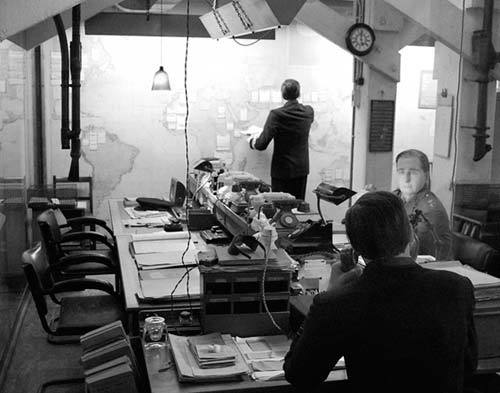
Cost and Hours: £19 includes audioguide, daily 9:30-18:00, last entry one hour before closing; on King Charles Street, 200 yards off Whitehall, follow the signs, Tube: Westminster, tel. 020/7930-6961, www.iwm.org.uk/churchill . The museum’s gift shop is great for anyone nostalgic for the 1940s.
Cabinet War Rooms: The 27-room, heavily fortified nerve center of the British war effort was used from 1939 to 1945. Churchill’s room, the map room, and other rooms are just as they were in 1945. As you follow the one-way route, be sure to take advantage of the audioguide, which explains each room and offers first-person accounts of wartime happenings here. Be patient—it’s well worth it. While the rooms are spartan, you’ll see how British gentility survived even as the city was bombarded—posted signs informed those working underground what the weather was like outside, and a cheery notice reminded them to turn off the light switch to conserve electricity.
Churchill Museum: Don’t bypass this museum, which occupies a large hall amid the war rooms. It dissects every aspect of the man behind the famous cigar, bowler hat, and V-for-victory sign. It’s extremely well-presented and engaging, using artifacts, quotes, political cartoons, clear explanations, and interactive exhibits to bring the colorful statesman to life. You’ll get a taste of Winston’s wit, irascibility, work ethic, passion for painting, American ties, writing talents, and drinking habits. The exhibit shows Winston’s warts as well: It questions whether his party-switching was just political opportunism, examines the basis for his opposition to Indian self-rule, and reveals him to be an intense taskmaster who worked 18-hour days and was brutal to his staffers (who deeply respected him nevertheless).
A long touch-the-screen timeline lets you zero in on events in his life from birth (November 30, 1874) to his first appointment as prime minister in 1940. Many of the items on display—such as a European map divvied up in permanent marker, which Churchill brought to England from the postwar Potsdam Conference—drive home the remarkable span of history this man influenced. Imagine: Churchill began his military career riding horses in the cavalry and ended it speaking out against nuclear proliferation. It’s all the more amazing considering that, in the 1930s, the man who would become my vote for greatest statesman of the 20th century was considered a washed-up loony ranting about the growing threat of fascism.
Eating: Get your rations at the $$ Switch Room café (until 17:00, in the museum), or for a nearby pub lunch, try $$ Westminster Arms (food served downstairs, on Storey’s Gate, a couple of blocks south of the museum).
The Horse Guards change daily at 11:00 (10:00 on Sun), and a colorful dismounting ceremony takes place daily at 16:00. The rest of the day, they just stand there—terrible for video cameras (at Horse Guards Parade on Whitehall, directly across from the Banqueting House, between Trafalgar Square and 10 Downing Street, Tube: Westminster, www.royal.gov.uk —search “Changing the Guard”). Buckingham Palace pageantry is canceled when it rains, but the Horse Guards change regardless of the weather.
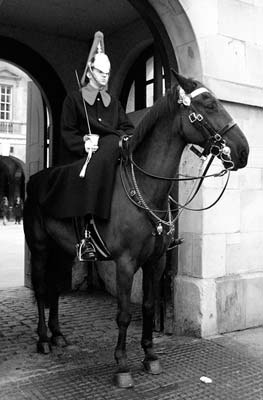
England’s first Renaissance building (1619-1622) is still standing. Designed by Inigo Jones, built by King James I, and decorated by his son Charles I, the Banqueting House came to symbolize the Stuart kings’ “divine right” management style—the belief that God himself had anointed them to rule. The house is one of the few London landmarks spared by the 1698 fire and the only surviving part of the original Palace of Whitehall. Today it opens its doors to visitors, who enjoy a restful 10-minute audiovisual history, a 45-minute audioguide, and a look at the exquisite banqueting hall itself. As a tourist attraction, it’s basically one big room, with sumptuous ceiling paintings by Peter Paul Rubens. At Charles I’s request, these paintings drove home the doctrine of the legitimacy of the divine right of kings. Ironically, in 1649—divine right ignored—King Charles I was famously executed right here.
Cost and Hours: £6.60 includes audioguide, daily 10:00-17:00, may close for government functions—though it promises to stay open at least until 13:00 (call ahead for recorded info), immediately across Whitehall from the Horse Guards, Tube: Westminster, tel. 020/3166-6155, www.hrp.org.uk .
 For a brief self-guided tour of the Banqueting House—and more details about its history—see here
in the Westminster
Walk. The Banqueting House is also covered on my
For a brief self-guided tour of the Banqueting House—and more details about its history—see here
in the Westminster
Walk. The Banqueting House is also covered on my  free Westminster Walk audio tour.
free Westminster Walk audio tour.
London’s renovated central square, the climax of most marches and demonstrations, is a thrilling place to simply hang out. Lord Nelson stands atop his 185-foot-tall fluted granite column, gazing out toward Trafalgar, where he lost his life but defeated the French fleet. Part of this 1842 memorial is made from his victims’ melted-down cannons. He’s surrounded by spraying fountains, giant lions, hordes of people, and—until recently—even more pigeons. A former London mayor decided that London’s “flying rats” were a public nuisance and evicted Trafalgar Square’s venerable seed salesmen (Tube: Charing Cross).
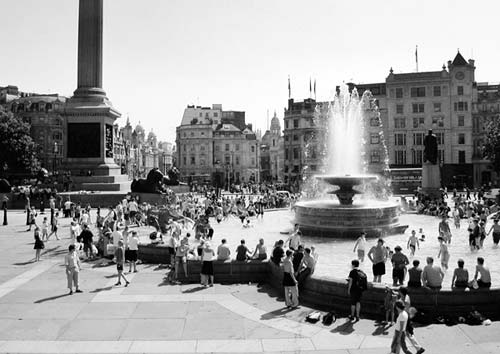
 For more on Trafalgar Square, see here
in the Westminster Walk. It’s also covered on my
For more on Trafalgar Square, see here
in the Westminster Walk. It’s also covered on my  free Westminster Walk audio tour.
free Westminster Walk audio tour.
Displaying an unsurpassed collection of European paintings from 1250 to 1900—including works by Leonardo, Botticelli, Velázquez, Rembrandt, Turner, Van Gogh, and the Impressionists—this is one of Europe’s great galleries. The collection is huge; following the route suggested in my self-guided tour will give you the best quick visit. For a more thorough tour, use the gallery’s excellent audioguide. Or pick out just one masterpiece or a handful of great artists using the gallery’s online “Short of Time” suggestions. Whatever time you spend here is worth it.
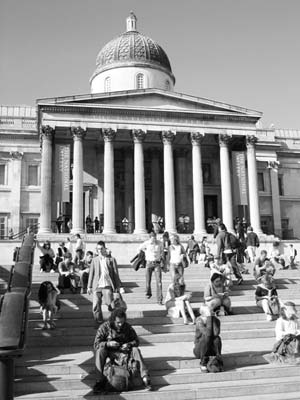
Cost and Hours: Free, £20 suggested donation, special exhibits extra, daily 10:00-18:00, Fri until 21:00, last entry to special exhibits 45 minutes before closing; daily free guided tours available, worthwhile audioguide-£4, floor plan-£1; on Trafalgar Square, Tube: Charing Cross or Leicester Square, recorded info tel. 020/7747-2885, switchboard tel. 020/7839-3321, www.nationalgallery.org.uk . The excellent-but-pricey $$$ National Dining Rooms in the museum, is a good spot for afternoon tea (see here ); the museum has cheaper eateries as well.
 See the National Gallery Tour chapter.
See the National Gallery Tour chapter.
Put off by halls of 19th-century characters who meant nothing to me, I used to call this “as interesting as someone else’s yearbook.” But a selective walk through this 500-year-long Who’s Who of British history is quick and free, and puts faces on the story of England.
Some highlights: Henry VIII and wives; portraits of the “Virgin Queen” Elizabeth I, Sir Francis Drake, and Sir Walter Raleigh; the only real-life portrait of William Shakespeare; Oliver Cromwell and Charles I with his head on; portraits by Gainsborough and Reynolds; the Romantics (William Blake, Lord Byron, William Wordsworth, and company); Queen Victoria and her era; and the present royal family, including the late Princess Diana and the current Duchess of Cambridge—Kate.
The collection is well-described, not huge, and in historical sequence, from the 16th century on the second floor to today’s royal family, usually housed on the ground floor.
Cost and Hours: Free, £5 suggested donation, special exhibits extra; daily 10:00-18:00, Thu-Fri until 21:00, first and second floors open Mon at 11:00, last entry to special exhibits one hour before closing; audioguide-£3, floor plan-£1; entry 100 yards off Trafalgar Square (around the corner from National Gallery, opposite Church of St. Martin-in-the-Fields), Tube: Charing Cross or Leicester Square, tel. 020/7306-0055, recorded info tel. 020/7312-2463, www.npg.org.uk .
 See the National Portrait Gallery Tour chapter.
See the National Portrait Gallery Tour chapter.
The church, built in the 1720s with a Gothic spire atop a Greek-type temple, is an oasis of peace on wild and noisy Trafalgar Square. St. Martin cared for the poor. “In the fields” was where the first church stood on this spot (in the 13th century), between Westminster and The City. Stepping inside, you still feel a compassion for the needs of the people in this neighborhood—the church serves the homeless and houses a Chinese community center. The modern east window—with grillwork bent into the shape of a warped cross—was installed in 2008 to replace one damaged in World War II.
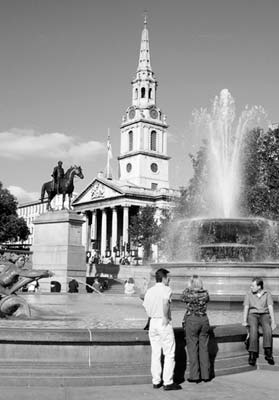
A freestanding glass pavilion to the left of the church serves as the entrance to the church’s underground areas. There you’ll find the concert ticket office, a gift shop, brass-rubbing center, and the recommended support-the-church Café in the Crypt.
Cost and Hours: Free, but donations welcome; hours vary but generally Mon-Fri 8:30-13:00 & 14:00-18:00, Sat 9:30-18:00, Sun 15:30-17:00; services listed at entrance; Tube: Charing Cross, tel. 020/7766-1100, www.stmartin-in-the-fields.org .
Music: The church is famous for its concerts. Consider a free lunchtime concert (£3.50 suggested donation; Mon, Tue, and Fri at 13:00), an evening concert (£9-28, several nights a week at 19:30), or Wednesday night jazz at the Café in the Crypt (£5.50-12 at 20:00). See the church’s website for the concert schedule.
(See "West End & Nearby" map, here .)
 The following areas are linked (and further described) in the West End Walk chapter.
The following areas are linked (and further described) in the West End Walk chapter.
Although this square is slathered with neon billboards and tacky attractions (think of it as the Times Square of London), the surrounding streets are packed with great shopping opportunities and swimming with youth on the rampage.
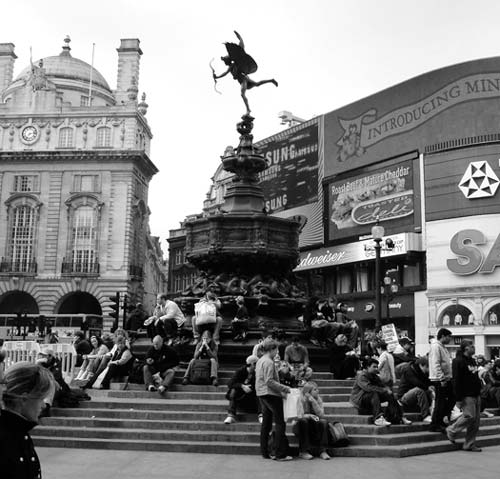
Nearby Shaftesbury Avenue and Leicester Square teem with fun-seekers, theaters, Chinese restaurants, and street singers. To the northeast is London’s Chinatown and, beyond that, the funky Soho neighborhood (described next). And curling to the northwest from Piccadilly Circus is genteel Regent Street, lined with exclusive shops.
North of Piccadilly, seedy Soho has become trendy—with many recommended restaurants—and is well worth a gawk. It’s the epicenter of London’s thriving, colorful youth scene, a fun and funky Sesame Street of urban diversity.
Soho is also London’s red light district (especially near Brewer and Berwick Streets), where “friendly models” wait in tiny rooms up dreary stairways, voluptuous con artists sell strip shows, and eager male tourists are frequently ripped off. But it’s easy to avoid trouble if you’re not looking for it. In fact, the sleazy joints share the block with respectable pubs and restaurants, and elderly couples stroll past neon signs that flash Licensed Sex Shop in Basement.
The centerpiece of this boutique-ish shopping district is an iron-and-glass arcade. The “Actors’ Church” of St. Paul, the Royal Opera House, and the London Transport Museum (described next) all border the square, and theaters are nearby. The area is a people-watcher’s delight, with cigarette eaters, Punch-and-Judy acts, food that’s not good for you (or your wallet), trendy crafts, and row after row of boutique shops and market stalls. For more on this square, see here . Better Covent Garden lunch deals can be found by walking a block or two away from the eye of this touristic hurricane (check out the places north of the Tube station, along Endell and Neal Streets, and see my suggestions on here ).
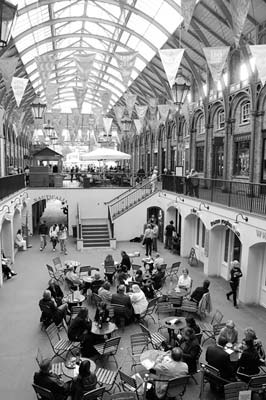
This modern, well-presented museum, located right at Covent Garden, is fun for kids and thought-provoking for adults (if a bit overpriced). Whether you’re cursing or marveling at the buses and Tube, the growth of Europe’s third-biggest city (after Istanbul and Moscow) has been made possible by its public transit system. Kids enjoy picking up the “stamp card,” then punching it with old-fashioned ticket punchers at the different exhibits.
Cost and Hours: £17, ticket good for one year, kids under 18 free, Sat-Thu 10:00-18:00, Fri 11:00-18:00, last entry 45 minutes before closing; pleasant upstairs café with Covent Garden view; in southeast corner of Covent Garden courtyard, Tube: Covent Garden, switchboard tel. 020/7379-6344, recorded info tel. 020/7565-7299, www.ltmuseum.co.uk .
Visiting the Museum: After you enter, take the elevator up to the top floor...and the year 1800, when horse-drawn vehicles ruled the road. London invented the notion of a public bus traveling a set route that anyone could board without a reservation. Next, you descend to the first floor and the world’s first underground Metro system, which used steam-powered locomotives (the Circle Line, c. 1865). On the ground floor, horses and trains are replaced by motorized vehicles (cars, taxis, double-decker buses, streetcars), resulting in 20th-century congestion. How to deal with it? In 2003, car drivers in London were slapped with a congestion charge, and today, a half-billion people ride the Tube every year. Learn how city planners hope to improve efficiency with better tracks and more coverage of the expanding East End. Finally, an exhibit lets you imagine futuristic modes of transportation waiting to become real.
This wonderful and compact collection of paintings is a joy. The gallery is part of the Courtauld Institute of Art, and the thoughtful description of each piece of art reminds visitors that the gallery is still used for teaching. You’ll see medieval European paintings and works by Rubens, the Impressionists (Manet, Monet, and Degas), Post-Impressionists (Cézanne and an intense Van Gogh self-portrait), and more. Besides the permanent collection, a quality selection of loaners and special exhibits are often included in the entry fee. The gallery is located within the grand Somerset House; enjoy the riverside eateries and the courtyard featuring a playful fountain.
Cost and Hours: £7, price can change depending on the exhibit; daily 10:00-18:00, occasionally open Thu until 21:00; in Somerset House on the Strand, Tube: Temple or Covent Garden, recorded info tel. 020/7848-2526, www.courtauld.ac.uk .
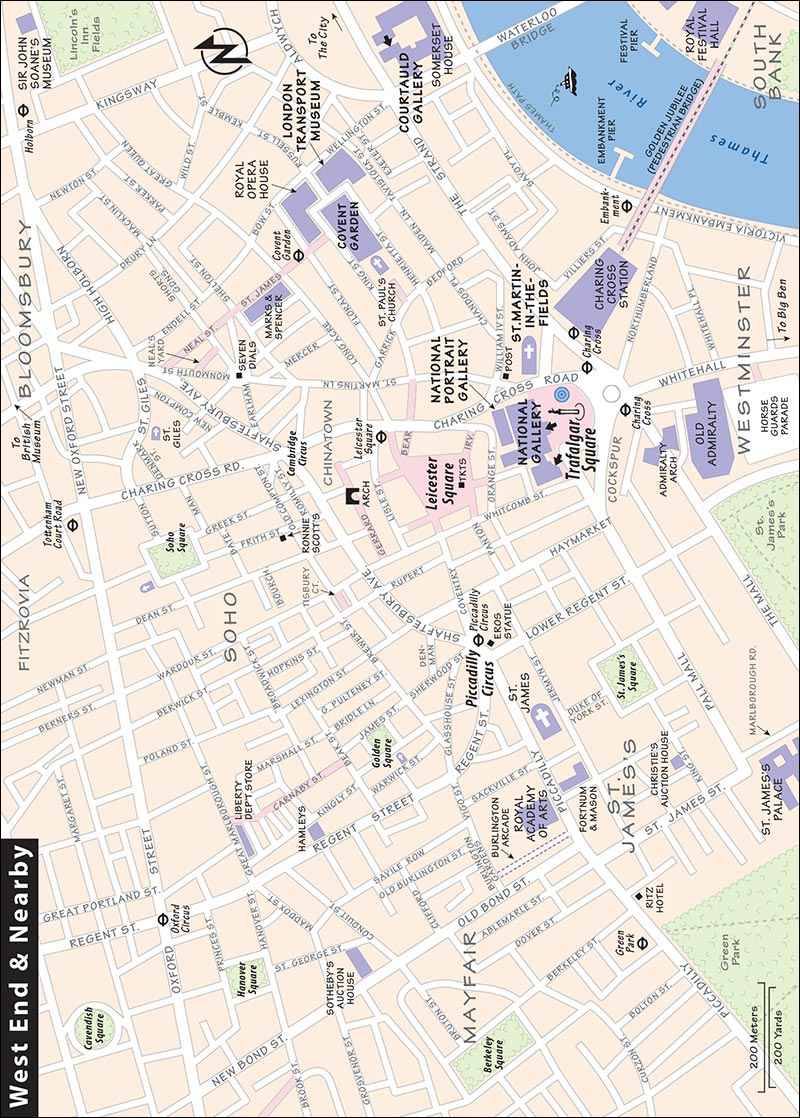
 See the Courtauld Gallery Tour chapter.
See the Courtauld Gallery Tour chapter.
(See "Buckingham Palace Area" map, here .)
The working headquarters of the British monarchy, Buckingham Palace is where the Queen carries out her official duties as the head of state. She and other members of the royal family also maintain apartments here. The property hasn’t always been this grand—James I (1603-1625) first brought the site under royal protection as a place for his mulberry plantation, for rearing silkworms.
Ticketing Options: Three palace sights require admission—the State Rooms (open Aug-Sept only), Queen’s Gallery, and Royal Mews. You can pay for each separately (prices listed next), or buy a combo-ticket: A £37 “Royal Day Out” combo-ticket admits you to all three sights; a £17.70 version covers the Queen’s Gallery and Royal Mews. For more information or to book online, see www.royalcollection.org.uk . Many tourists are more interested in the Changing of the Guard, which costs nothing at all to view. For locations, see map on here .
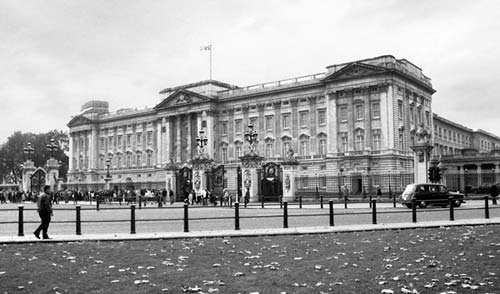
This lavish home has been Britain’s royal residence since 1837, when the newly ascended Queen Victoria moved in. When today’s Queen is at home, the royal standard flies (a red, yellow, and blue flag); otherwise, the Union Jack flaps in the wind. The Queen opens her palace to the public—but only in August and September, when she’s out of town.
Cost and Hours: £21.50 for lavish State Rooms and throne room, includes audioguide; Aug-Sept only, daily 9:30-18:30, until 19:00 in Aug, last admission 17:15 in Aug, 16:15 in Sept; limited to 8,000 visitors a day by timed entry; come early to the palace’s Visitor Entrance (opens 9:00), or book ahead in person, by phone, or online; Tube: Victoria, tel. 0303/123-7300—but Her Majesty rarely answers.
A small sampling of Queen Elizabeth’s personal collection of art is on display in five rooms in a wing adjoining the palace. Her 7,000 paintings, one of the largest private art collections in the world, are actually a series of collections built upon by each successive monarch since the 16th century. The Queen rotates the paintings, enjoying some privately in her many palatial residences while sharing others with her subjects in public galleries in Edinburgh and London. The exhibits change two or three times a year and are lovingly described by the included audioguide.
Because the gallery is small and security is tight (involving lines), I’d suggest visiting this gallery only if you’re a patient art lover interested in the current exhibit.
Cost and Hours: £10.30 but can change depending on exhibit, daily 10:00-17:30, from 9:30 Aug-Sept, last entry one hour before closing, Tube: Victoria, tel. 0303/123-7301. Men shouldn’t miss the mahogany-trimmed urinals.
A visit to the Queen’s working stables is likely to be disappointing unless you follow the included audioguide or the hourly guided tour (April-Oct only, 45 minutes), in which case it’s fairly entertaining—especially if you’re interested in horses and/or royalty. You’ll see only a few of the Queen’s 30 horses (most active between 10:00 and 12:00), a fancy car, and a bunch of old carriages, finishing with the Gold State Coach (c. 1760, 4 tons, 4 mph). Queen Victoria said absolutely no cars. When she died, in 1901, the mews got its first Daimler. Today, along with the hay-eating transport, the stable is home to five Bentleys and Rolls-Royce Phantoms, with at least one on display.
Cost and Hours: £9.30, April-Oct daily 10:00-17:00, Nov-March Mon-Sat 10:00-16:00, closed Sun; last entry 45 minutes before closing, generally busiest immediately after changing of the guard, guided tours on the hour in summer; Buckingham Palace Road, Tube: Victoria, tel. 0303/123-7302.
This is the spectacle every visitor to London has to see at least once: stone-faced, red-coated (or in winter, gray-coated), bearskin-hatted guards changing posts with much fanfare, in an hour-long ceremony accompanied by a brass band.
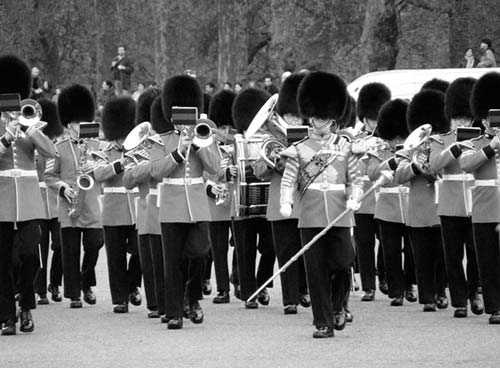
It’s 11:00 at Buckingham Palace, and the on-duty guards (the “Queen’s Guard”) are ready to finish their shift. Nearby at St. James’s Palace (a half-mile northeast), a second set of guards is also ready for a break. Meanwhile, fresh replacement guards (the “New Guard”) gather for a review and inspection at Wellington Barracks, 500 yards east of the palace (on Birdcage Walk).
At 11:13, the tired St. James’s “Old Guard” heads out to the Mall, and then takes a right turn for Buckingham Palace. At 11:27, the “New Guard” replacement troops, led by the band, also head for Buckingham Palace from the Wellington Barracks. Meanwhile, a fourth group—the Horse Guard—passes by along the Mall on its way back to Hyde Park Corner from its own changing-of-the-guard ceremony on Whitehall (which just took place at Horse Guards Parade at 11:00, or 10:00 on Sun).
At 11:30, the tired and fresh guards converge on Buckingham Palace in a perfect storm of red-coat pageantry. Everyone parades around, the guard changes (passing the regimental flag, or “colour”) with much shouting, the band plays a happy little concert, and then they march out. Just after noon, two bands escort two detachments of guards away: the tired “Old Guard” to Wellington Barracks and the fresh “New Guard” to St. James’s Palace. As the fresh guards set up at St. James’s Palace and the tired ones dress down at the barracks, the tourists disperse.
Cost and Hours: Free, daily May-July at 11:30, every other day Aug-April, no ceremony in very wet weather; exact schedule subject to change—call 020/7766-7300 for the day’s plan, or check www.royal.gov.uk (search “Changing the Guard”); Buckingham Palace, Tube: Victoria, St. James’s Park, or Green Park. Or hop into a big black taxi and say, “Buck House, please.”
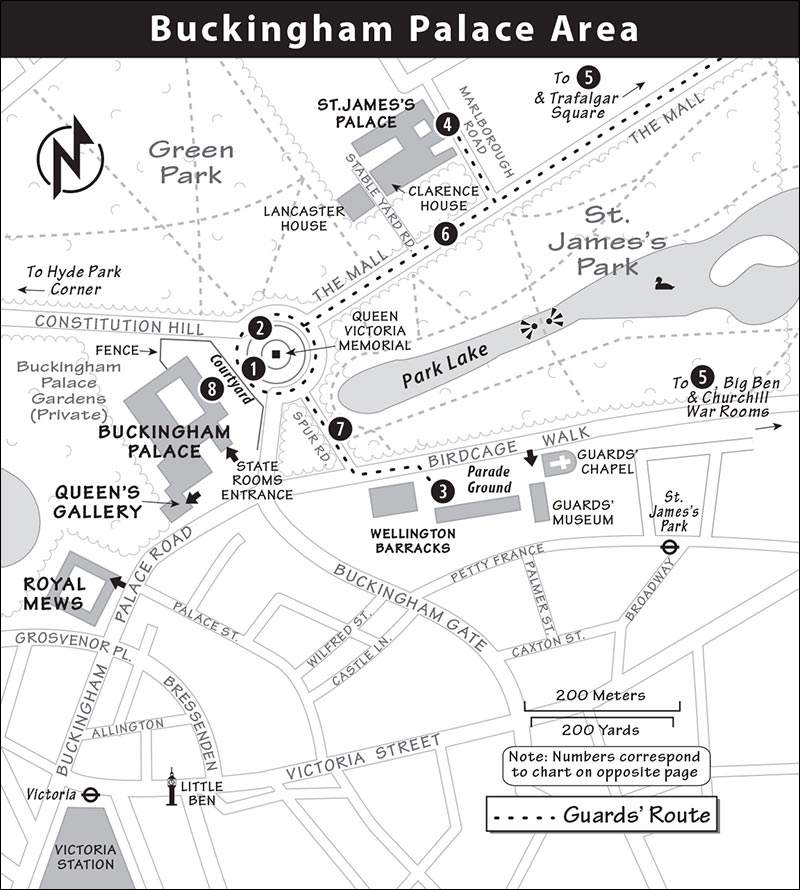
Sightseeing Strategies: Most tourists just show up and get lost in the crowds, but those who anticipate the action and know where to perch will enjoy the event more. The action takes place in stages over the course of an hour, at several different locations; see the map. There are several ways to experience the pageantry. Get out your map (or download the official app at www.royalcollection.org.uk ) and strategize. Here are a few options to consider:
Watch from One Location: Pick one event and find a good, unobstructed place from which to view it. The key is to get either right up front along the road or fence, or find some raised elevation to stand or sit on—a balustrade or a curb—so you can see over people’s heads. The main event is in the forecourt right in front of Buckingham Palace (between Buckingham Palace and the fence) from 11:30 to 12:00. To see it close up, you’ll need to get here no later than 10:30 to get a place front and center, next to the fence.
If you get there too late to score a premium spot right along the fence, head for the high ground on the circular Victoria Memorial, which provides the best overall view (come before 11:00 to get a place). From a high spot on the memorial, you have good (if more distant) views of the palace as well as the arriving and departing parades along The Mall and Spur Road. The actual Changing of the Guard in front of the palace is a nonevent. It is interesting, however, to see nearly every tourist in London gathered in one place at the same time.
If you arrive too late to get any good spot at all, or you just don’t feel like jostling for a view, stroll down to St. James’s Palace and wait near the corner for a great photo-op. At about 12:15, the parade marches up The Mall to the palace and performs a smaller changing ceremony—with almost no crowds. Afterward, stroll through nearby St. James’s Park.
Follow the Procession: You won’t get the closest views, but you’ll get something even better—the thrill of participating in the action. Start with the “Old Guard” mobilizing in the courtyard of St. James’s Palace (11:00). Arrive early, and grab a spot just across the road (otherwise you’ll be asked to move when the inspection begins). Just before they prepare to leave (at 11:13), march ahead of them down Marlborough Street to The Mall. Pause here to watch them parade past, band and all, on their way to the Palace, then cut through the park and head to the Wellington Barracks—where the “New Guard” is getting ready to leave for Buckingham (11:27). March along with full military band and fresh guards from the barracks to the Palace. At 11:30 the two guard groups meet in the courtyard, the band plays a few songs, and soldiers parade and finally exchange compliments before returning to Wellington Barracks and St. James’s Palace (12:10). Use this time to snap a few photos of the guards—and the crowds—before making your way across the Mall to Clarence House (on Stable Yard Road), where you’ll see the “New Guard” pass one last time on their way to St. James’s Palace. On their way, the final piece of ceremony takes place—one member of the “Old Guard” and one member of the first-relief “New Guard” change places here.
Join a Tour: Local tour companies such as Fun London Tours more or less follow the self-guided route above but add in history and facts about the guards, bands, and royal family to their already entertaining march. These walks add color and good value to what can otherwise seem like a stressful mess of tourists (£15, Changing of the Guard tour starts at Piccadilly Circus at 10:00, must book online in advance, www.funlondontours.com ).
(See "North London" map, here .)
Simply put, this is the greatest chronicle of civilization...anywhere. A visit here is like taking a long hike through Encyclopedia Britannica National Park. The vast British Museum wraps around its Great Court (the huge entrance hall), with the most popular sections filling the ground floor: Egyptian, Assyrian, and ancient Greek, with the famous frieze sculptures from the Parthenon in Athens. The museum’s stately Reading Room—famous as the place where Karl Marx hung out while formulating his ideas on communism and writing Das Kapital —sometimes hosts special exhibits.
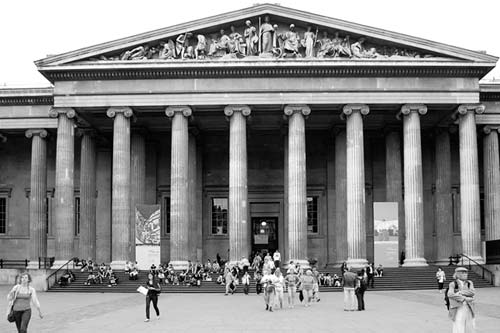
Cost and Hours: Free but a £5 donation requested, special exhibits usually extra (and with timed ticket); daily 10:00-17:30, Fri until 20:30 (selected galleries only), least crowded late on weekday afternoons, especially Fri; free guided tours offered, videoguide-£5; Great Russell Street, Tube: Tottenham Court Road, general info tel. 020/7323-8299, ticket desk tel. 020/7323-8181, www.britishmuseum.org .
 See the British Museum Tour chapter or
See the British Museum Tour chapter or  download my free audio tour.
download my free audio tour.
Here, in just two rooms, are the literary treasures of Western civilization, from early Bibles to Shakespeare’s Hamlet to Lewis Carroll’s Alice’s Adventures in Wonderland to the Magna Carta. You’ll see the Lindisfarne Gospels transcribed on an illuminated manuscript, Beatles lyrics scrawled on the back of a greeting card, and Leonardo da Vinci’s genius sketched into his notebooks. The British Empire built its greatest monuments out of paper; it’s through literature that England made her most lasting and significant contribution to civilization and the arts.
Cost and Hours: Free, £5 suggested donation, admission charged for some special exhibits; Mon-Fri 9:30-18:00, Tue-Thu until 20:00, Sat 9:30-17:00, Sun 11:00-17:00; 96 Euston Road, Tube: King’s Cross St. Pancras or Euston, tel. 019/3754-6060 or 020/7412-7676, www.bl.uk .
 See the British Library Tour chapter or
See the British Library Tour chapter or  download my free audio tour.
download my free audio tour.
Sir Richard Wallace’s fine collection of 17th-century Dutch Masters, 18th-century French Rococo, medieval armor, and assorted aristocratic fancies fills the sumptuously furnished Hertford House on Manchester Square. From the rough and intimate Dutch lifescapes of Jan Steen to the pink-cheeked Rococo fantasies of François Boucher, a wander through this little-visited mansion makes you nostalgic for the days of the empire. This collection would be a big deal in a midsized city, but here in London it gets pleasantly lost. Because this is a “closed collection” (nothing new is acquired and nothing permanent goes on loan), it feels more like visiting a classic English manor estate than a museum. It’s thoroughly enjoyable.
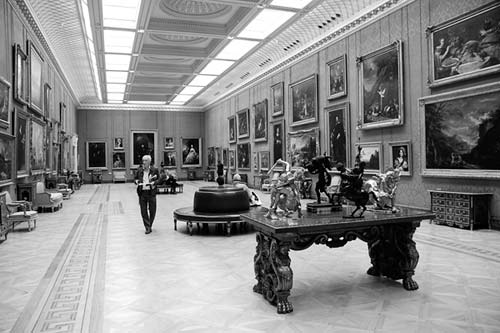
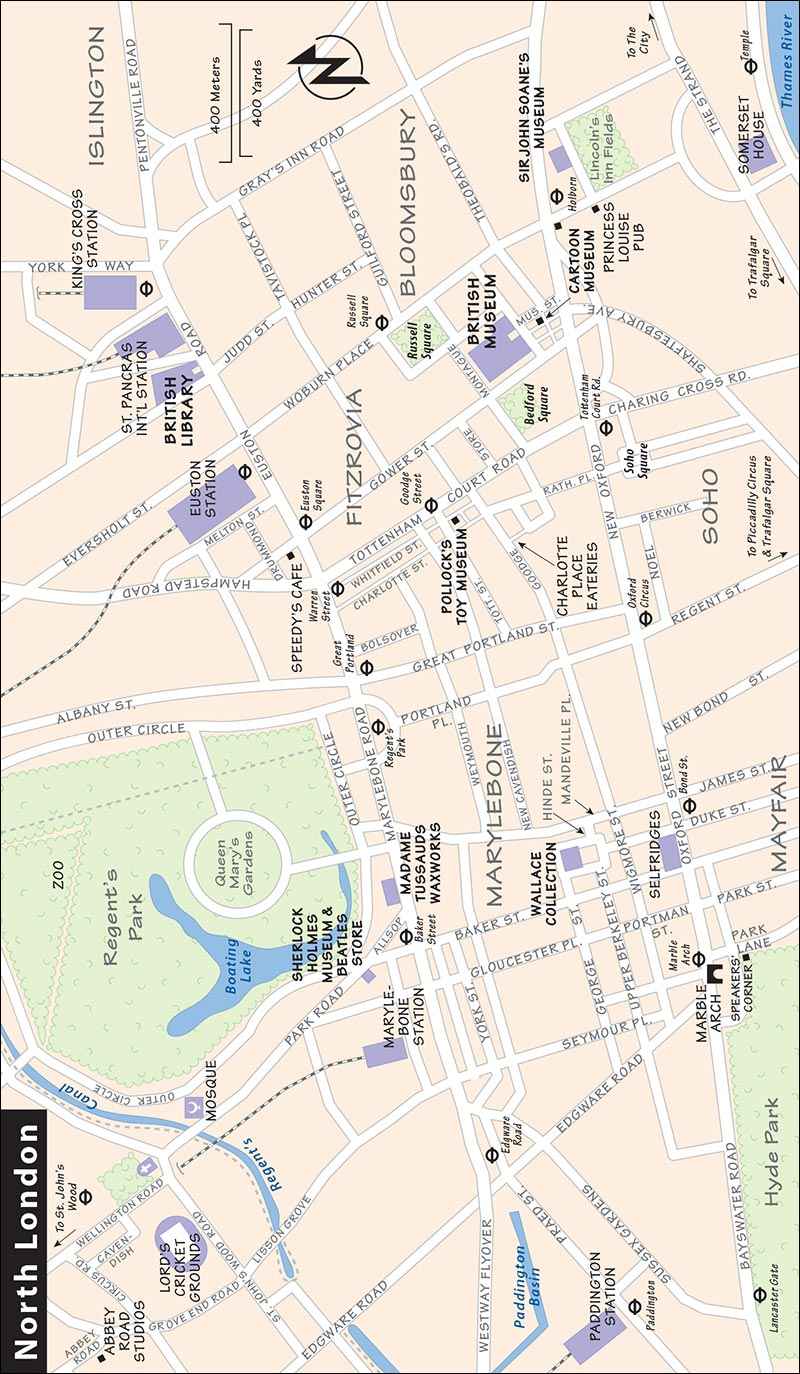
Sir Richard Wallace’s biography is as peculiar as the collection. Born the recognized–but-illegitimate son of Richard Seymour-Conway, 4th Marquess of Hertford, Wallace was denied the ancestral title but inherited the family collection at his father’s death, became a respected philanthropist, and was eventually knighted by Queen Victoria. Upon his own death his widow bestowed the collection to the people of England under the clever condition that it retain the name Wallace, and not the name of his father.
Cost and Hours: Free, £5 suggested donation, daily 10:00-17:00, audioguide-£4; free guided tours or lectures almost daily at 11:30, 13:00, and 14:30—call or check online to confirm times; just north of Oxford Street on Manchester Square, Tube: Bond Street, tel. 020/7563-9500, www.wallacecollection.org .
Visiting the Museum: The manageable collection is displayed on three floors—not much in the basement; fine arts, medieval treasures, and armor on the ground floor; and an even finer painting collection on the top floor.
As you enter the ground floor, on the right you’ll find drawing rooms filled with medieval relics, and to the left (through the gift shop) are the collections of Oriental and European armor—one of the finest such collections in Britain. Then head up the red-carpeted grand staircase to the upper floor, packed with paintings.
The Oval Drawing Room is busy with Boucher and Fragonard—pink, giddy, and Rococo. A highlight is the small but symbolism-packed Rococo masterpiece The Swing (1767), by Jean-Honoré Fragonard. The woman is being pulled on the swing by her husband. He’s on the right, hidden in shadows, literally “in the dark”—unaware that his wife is having an affair with the man hiding in the bushes on the left. The rascal holds his arm erect as he peeps up this swinging lady’s skirt and watches her shoe fly off, symbolizing sexual abandon.
The Great Gallery contains paintings by the big names of the 17th century: Rembrandt, Rubens, Velázquez, Titian, Van Dyck, Murillo, and Hals. One of the museum’s best-known paintings is The Laughing Cavalier (1624) by Frans Hals (see photo). With his hat perched at a jaunty angle, the man smirks enigmatically with unhappy eyes...more of a polite chuckle or a bemused snort.

The Boudoir Cabinet is a tiny room that glitters with exquisite bits of 18th-century French luxury: jeweled snuff boxes, miniatures (a sign of friendship or political allegiance), and spanky pornography for the upper class.
The West Gallery takes you on a trip to 18th-century Venice. It’s filled with romantically staged scenes painted by Canaletto and Guardi—purchased as souvenirs by aristocrats on the Grand Tour before the age of postcards. The East Gallery is interesting for its small-scale 17th-century Dutch paintings by Jan Steen and others who could paint quiet, intimate, and rowdy slices of life—usually conveying a folk moral rather than a religious lesson.
Then head back down to the main floor and go out the door behind the staircase, into the building’s gorgeous glassed-in atrium, filled with light and a $$$ restaurant serving reasonably priced afternoon tea (£6.50 cream tea, £18.50 English tea, similar hours as museum).
This waxtravaganza is gimmicky, crass, and crazily expensive, but dang fun...a hit with the kind of tourists who skip the British Museum. The original Madame Tussaud did wax casts of heads lopped off during the French Revolution (such as Marie-Antoinette’s). She took her show on the road and ended up in London in 1835. These days, they’ve dumped anything really historical (except for what they claim is the blade that beheaded Marie-Antoinette) because “there’s no money in it and we’re a business.” Now it’s all about squeezing Leonardo DiCaprio’s bum, singing with Lady Gaga, and partying with Brangelina, Benedict Cumberbatch, and the Beatles. The gallery, which sprawls through several rooms of a huge building, is one giant photo-op—the whole point is jockeying for position to snap the best picture of your travel buddy with a famous “person.” It’s extremely crowded and chaotic, as everyone clamors to press the wax with their heroes, while dodging tourist-trinket kiosks and photographers standing by to overcharge you for a print. These wax sculptures are eerily realistic—count how many times you say “excuse me” after bumping into a dummy.
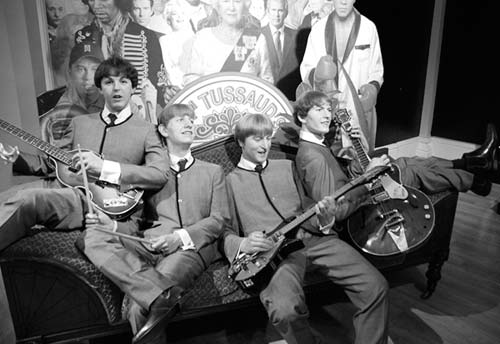
Cost: £34, kids-£29.80 (free for kids under 5), family passes available online; up to 25 percent discount and shorter lines if you buy tickets on their website (also consider a combo-deal with the London Eye); two-for-one rail vouchers accepted (see here ).
Hours: July-Aug and school holidays daily 8:30-19:30, Sept-June Mon-Fri 9:30-17:30, Sat-Sun 9:00-18:00, these are last entry times—it stays open roughly two hours later; Marylebone Road, Tube: Baker Street, tel. 0871-894-3000, www.madametussauds.com .
Crowd-Beating Tips: This popular attraction can be swamped. The ticket-buying line can be an hour or more (believe the posted signs about the wait). Once inside, there can be more waits for some popular exhibits. To avoid the ticket line, buy a Priority Entrance ticket and reserve a time slot at least a day in advance, or purchase a Fast Track ticket in advance—available from souvenir stands and other shops around town or at the TI. The place is less crowded (for both buying tickets at the door and for simply enjoying the place) if you arrive after 15:00.
Visiting the Waxworks: First you’ll join the paparazzi on the red carpet with A-list stars, then you’ll head through several themed sections, featuring Hollywood stars new and old, sports heroes (including some unfamiliar-to-Americans cricket players and footballers), the royal family (pose with the Queen, Will, and Kate...or settle for Charles and Camilla), scientists, artists, writers, musicians, and world leaders. (Even Hitler has a wax figure. Ouch.)
Downstairs are exhibits that sometimes have lines—pick and choose if it’s worth the wait. A small exhibit explains the casting process and the history of Madame Tussaud and her waxy army. Then you’ll board a Disney-type people-mover and cruise through a kid-pleasing “Spirit of London” once-over-very-light history of this city. Finally, you reach a nine-minute-long Marvel Super Heroes “4-D” show—a 3-D movie heightened by wind, “back ticklers,” and other special effects. It’s totally silly, requires a wait in line, and leaves the crowd buzzing with sensory overload—a fitting finale to the entire Waxworks experience.
Architects love this quirky place, as do fans of interior decor, eclectic knickknacks, and Back Door sights. Tour this furnished home on a bird-chirping square and see 19th-century chairs, lamps, wood-paneled nooks and crannies, sculptures, and stained-glass skylights just as they were when the owner lived here. As professor of architecture at the Royal Academy, Soane created his home to be a place of learning, cramming it floor to ceiling with ancient relics, curios, and famous paintings, including several excellent Canalettos and Hogarth’s series on The Rake’s Progress (which is hidden behind a panel in the Picture Room and opened randomly at the museum’s discretion, usually twice an hour). Soanes even purchased the Egyptian sarcophagus of King Seti I (Ramesses II’s father, on display in the basement) after the British Museum turned it down—at the time, they couldn’t afford the £2,000 sticker price.
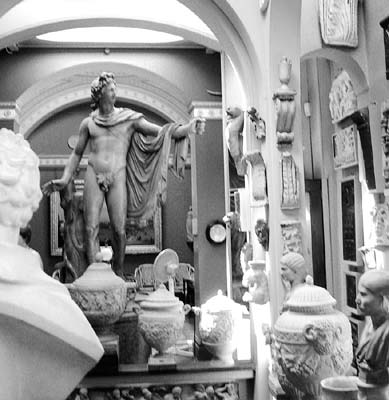
In 1833, just before his death, Soane established his house as a museum, stipulating that it be kept as nearly as possible in the state he left it. If he visited today, he’d be entirely satisfied by the diligence with which the staff safeguards his treasures. You’ll leave wishing you’d known the man.
Cost and Hours: Free, but donations much appreciated; Tue-Sat 10:00-17:00, open and candlelit the first Tue of the month 18:00-21:00 (limited to 250 people), closed Sun-Mon; often long entry lines (especially Sat), knowledgeable volunteers in most rooms, guidebook-£5; £10 guided tour must be booked ahead online and runs Tue, Thu, Fri, and Sat at 12:00; 13 Lincoln’s Inn Fields, quarter-mile southeast of British Museum, Tube: Holborn, tel. 020/7405-2107, www.soane.org .
This humble but interesting museum is located in the shadow of the British Museum. While its three rooms are filled with British cartoons unknown to most Americans, the satirical takeoffs on famous bigwigs and politicians—including Napoleon, Margaret Thatcher, the Queen, and Tony Blair—show the power of parody to deliver social commentary. Upstairs are panels of well-known comics that will interest only diehard fans.
Cost and Hours: £7, Mon-Sat 10:30-17:30, Sun 12:00-17:30, 35 Little Russell Street—go one block south of the British Museum on Museum Street and turn right, Tube: Tottenham Court Road, tel. 020/7580-8155, www.cartoonmuseum.org .
This rickety old house, with glass cases filled with toys and games lining its walls and halls, is a time-warp experience that brings back childhood memories to people who grew up without batteries or computer chips. It also gives a sense of the history of childhood itself, starting from when “childhood” as we know it now first came to be. Though the museum is small, you could spend a lot of time here, squinting at the fascinating toys and well-loved dolls that entertained the children of 19th- and early 20th-century England.
The included information is great. The story of Theodore Roosevelt refusing to shoot a bear cub while on a hunting trip was celebrated in 1902 cartoons, resulting in a new, huggable toy: the Teddy Bear. It was popular for good reason: It could be manufactured during World War I without rationed products; it coincided with the new belief that soft toys were good for a child’s development; it was an acceptable “doll for boys”; and it was the toy children kept long after they’d grown up.
Cost and Hours: £6, kids-£3, Mon-Sat 10:00-17:00, closed Sun, 1 Scala Street, Tube: Goodge Street, tel. 020/7636-3452, www.pollockstoys.com . A fun retro toy shop is attached.
London’s city center is surprisingly devoid of sights associated with the famous ’60s rock band. To see much of anything, consider taking a guided walk (see here ).
For a photo op, go to Abbey Road and walk the famous crosswalk pictured on the Abbey Road album cover (Tube: St. John’s Wood, get information and buy Beatles memorabilia at the small kiosk in the station). From the Tube station, it’s a five-minute walk west down Grove End Road to the intersection with Abbey Road. The Abbey Road recording studio is the low-key white building to the right of Abbey House (it’s still a working studio, so you can’t go inside). Ponder the graffiti on the low wall outside, and...imagine. To re-create the famous cover photo, shoot the crosswalk from the roundabout as you face north up Abbey Road. Shoes are optional.
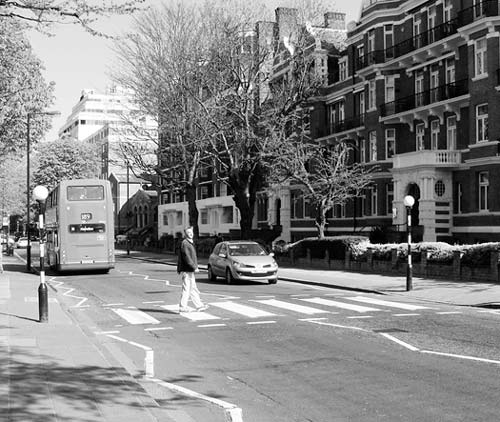
Nearby is Paul McCartney’s current home (7 Cavendish Avenue): Continue down Grove End Road, turn left on Circus Road, and then right on Cavendish. Please be discreet.
The Beatles Store is at 231 Baker Street (Tube: Baker Street). It’s small—some Beatles-logo T-shirts, mugs, pins, and old vinyl like you might have in your closet—and has nothing of historic value (open eight days a week, 10:00-18:30, tel. 020/7935-4464, www.beatlesstorelondon.co.uk ; another rock memorabilia store is across the street).
A few doors down from the Beatles Store, this meticulous recreation of the (fictional) apartment of the (fictional) detective sits at the (real) address of 221b Baker Street. The first-floor replica (so to speak) of Sherlock’s study delights fans with the opportunity to play Holmes and Watson while sitting in authentic 18th-century chairs. The second and third floors offer fine exhibits on daily Victorian life, showing off furniture, clothes, pipes, paintings, and chamber pots; in other rooms, models are posed to enact key scenes from Sir Arthur Conan Doyle’s famous books.
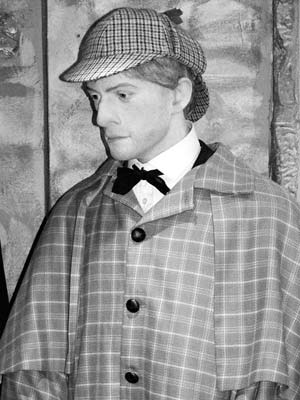
Cost and Hours: £15, daily 9:30-18:00, expect to wait 15 minutes or more—up to 2 hours in peak season; buy tickets inside the gift shop first, then get in line outside the museum (if you’re traveling with a partner, send one person in to buy tickets while the other waits in the entrance line); large gift shop for Holmes connoisseurs, including souvenirs from the BBC-TV series; Tube: Baker Street, tel. 020/7935-8866, www.sherlock-holmes.co.uk .
Nearby: Fans of BBC-TV’s “Sherlock” series starring Benedict Cumberbatch—which this museum doesn’t cover—may want to have lunch or snap a photo at Speedy’s Café, the filming location for the show’s 221b exterior (at 187 North Gower Street, an easy Tube ride to Euston Square).
(See "The City, The Tower & East London" map, here .)
When Londoners say “The City,” they mean the one-square-mile business center in East London that 2,000 years ago was Roman Londinium. The outline of the Roman city walls can still be seen in the arc of roads from Blackfriars Bridge to Tower Bridge. Within The City are 23 churches designed by Sir Christopher Wren, mostly just ornamentation around St. Paul’s Cathedral. Today, while home to only 10,000 residents, The City thrives with around 400,000 office workers coming and going daily. It’s a fascinating district to wander on weekdays, but since almost nobody actually lives there, it’s dull in the evenings and on Saturday and Sunday.
 See the Historic London: The City Walk chapter or
See the Historic London: The City Walk chapter or  download my free audio tour.
download my free audio tour.
Wren’s most famous church is the great St. Paul’s, its elaborate interior capped by a 365-foot dome. Since World War II, St. Paul’s has been Britain’s symbol of resilience. Despite 57 nights of bombing, the Nazis failed to destroy the cathedral, thanks to St. Paul’s volunteer fire watchmen, who stayed on the dome. Today you can climb the dome for a great city view. The crypt (included with admission) is a world of historic bones and memorials, including Admiral Nelson’s tomb and interesting cathedral models.
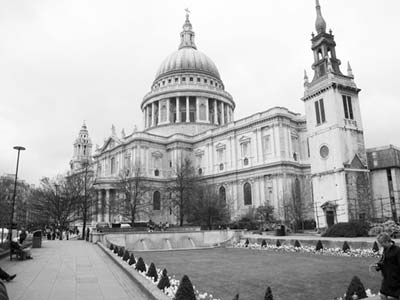
Cost and Hours: £18, £16 if purchased in advance on the website, includes church entry, dome climb, crypt, tour, and audioguide; Mon-Sat 8:30-16:30 (dome opens at 9:30), closed Sun except for worship; book ahead online to skip the line or you might wait 15-30 minutes at busy times, guided tours offered; Tube: St. Paul’s, recorded info tel. 020/7246-8348, reception tel. 020/7246-8350, www.stpauls.co.uk .
Music: The evensong services are free (Sun 15:15, Tue-Sat 17:00, not on Mon), but nonpaying visitors are not allowed to linger afterward (see here for details).
Cheap Trick: To get a free cityscape view nearly as good as the expensive view from St. Paul’s dome, head for the rooftop terrace at One New Change shopping mall, just behind the church. To reach it, walk through the churchyard (to the left of the church as you face it), cross the busy street, turn right and head toward One New Change. Behind the escalators, you’ll find glass elevators where you can ride to the top floor for an amazing view of St Paul’s and a fine view of London.
 See the St. Paul’s Cathedral Tour chapter or
See the St. Paul’s Cathedral Tour chapter or  download my free audio tour.
download my free audio tour.
To view the British legal system in action—lawyers in little blond wigs speaking legalese with an upper-crust accent—spend a few minutes in the visitors’ gallery at the Old Bailey courthouse, called the “Central Criminal Court.” Don’t enter under the dome; continue up the block about halfway to the modern part of the building—the entry is at Warwick Passage.
Cost and Hours: Free, generally Mon-Fri 10:00-13:00 & 14:00-17:00 depending on caseload, last entry at 12:40 and 15:40 but often closes an hour or so earlier, closed Sat-Sun, fewer cases in Aug; no kids under 14; 2 blocks northwest of St. Paul’s on Old Bailey Street (down a tunnel called Warwick Passage, follow signs to public entrance), Tube: St. Paul’s, tel. 020/7248-3277 www.cityoflondon.gov.uk .
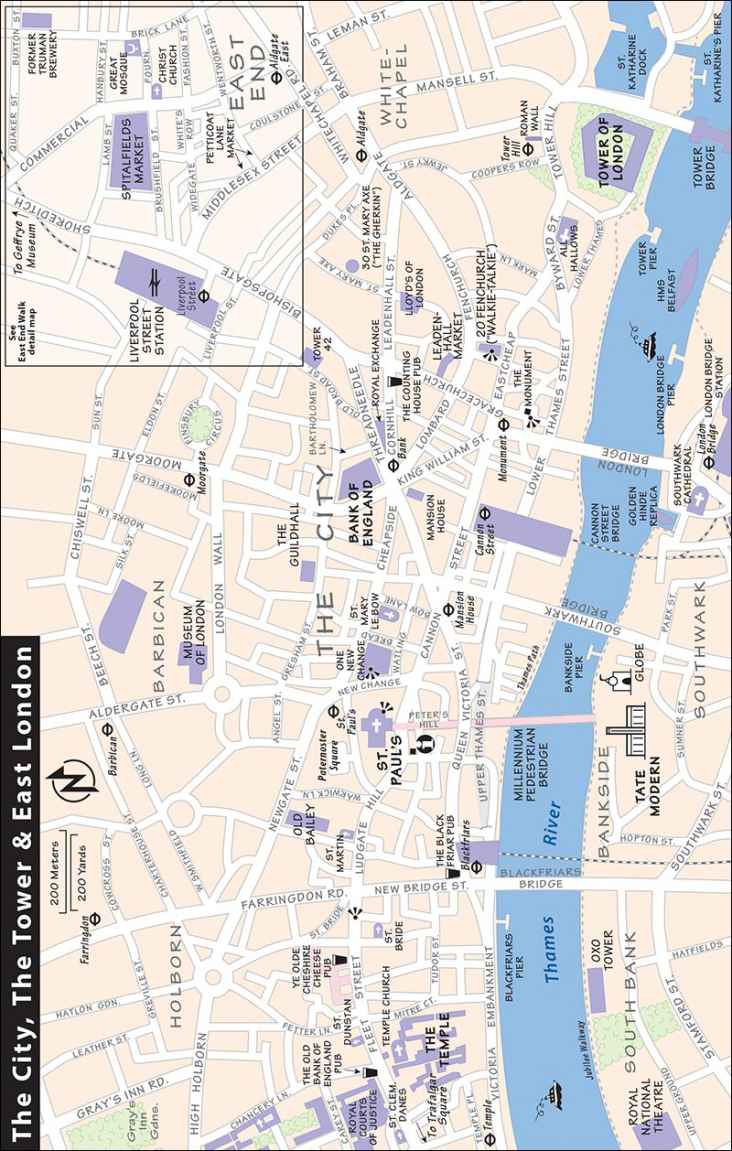
Bag Check: Old Bailey has a strictly enforced policy of no bags, mobile phones, cameras, computers, or food. Small purses are OK (but no phones or cameras inside). You can check bags at the Capable Travel agency just down the street at 4 Old Bailey for £5/bag and £1/phone or camera; or at the nearby Museum of London for £1.
Hiding out in The City, the Guildhall offers visitors a grand medieval hall and a delightful painting gallery for free. This area has been a gathering place since ancient Roman times (on the square, note the circular outline of the Roman amphitheater that once stood here). The meeting spot for guilds in medieval times, it still hosts about 100 professional associations today. The venerable hall, which survived both the Great Fire of 1666 and bombing in World War II, dates from the 15th century and is a rare bit of civil architecture surviving from the Middle Ages.
Adjoining the old hall is the Guildhall Art Gallery, giving insight into old London society with mostly Victorian paintings of numerous London scenes. One of best Victorian collections in London, it’s well-described and organized into themes (home, beauty, faith, leisure, work, love, and imagination), and includes dreamy Pre-Raphaelite works. In the basement is a well-presented exhibit on a Roman amphitheater discovered during a building project in 1988.
Cost and Hours: Free, Mon-Sat 10:00-17:00, Sun 12:00-16:00, 6 blocks northeast of St. Paul’s on Gresham Street, Tube: St. Paul’s or Bank, tel. 020/7332-3404, www.guildhall.cityoflondon.gov.uk .
This museum tells the fascinating story of London, taking you on a walk from its pre-Roman beginnings to the present. It features London’s distinguished citizens through history—from Neanderthals, to Romans, to Elizabethans, to Victorians, to Mods, to today. The displays are chronological, spacious, and informative without being overwhelming. Scale models and costumes help you visualize everyday life in the city at different periods. There are enough whiz-bang multimedia displays (including the Plague and the Great Fire) to spice up otherwise humdrum artifacts. This regular stop for the local school kids gives the best overview of London history in town.
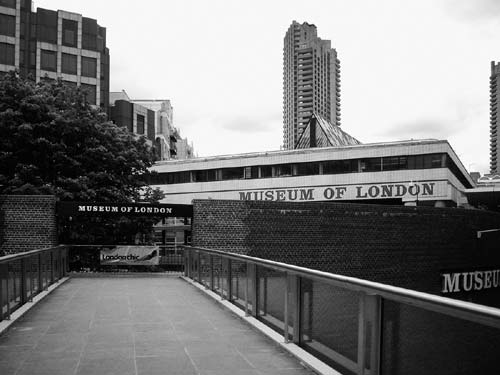
Cost and Hours: Free, daily 10:00-18:00, last entry one hour before closing, see the day’s events board for special talks and tours, café, baggage lockers, 150 London Wall at Aldersgate Street, Tube: Barbican or St. Paul’s plus a five-minute walk, tel. 020/7001-9844, www.museumoflondon.org.uk .
Visiting the Museum: The first part of the tour zips quickly through a half-million years, when Britain morphed from peninsula to island, Neanderthals speared mammoths, and Stone Age humans huddled in crude huts on the South Bank of the Thames.
In 54 B.C., Julius Caesar invaded, and the Romans built “Londinium” on the north bank. The settlement quickly became the hub of Britain and a river-trade town, complete with arenas, forums, baths, a bridge across the Thames, and a city wall. That wall—arcing from the present Tower of London to St. Paul’s—defined the city’s boundaries for the next 1,500 years. The Museum of London sits on the northwest perimeter of the city wall—look out the windows to see a crumbling remnant along the street, now called “London Wall.”
When Rome could no longer defend the city (A.D. 410), it fell to the Saxons (becoming “Lundenburg”) and, later, the Normans (in 1066), who built the Tower of London. Medieval London was devastated by the Black Death plague of 1348. As the city recovered and grew even bigger, it became clear to wannabe kings that whoever controlled London controlled Britain.
Downstairs, the next millennium of London unfolds. When Queen Elizabeth I brought peace to the land, London thrived as a capital of theaters (the Globe and Rose), arts, and ideas. Then, just when things were going so well, the Great Fire of 1666 destroyed the city, leaving London a blank slate.
Take a stroll through a recreated Georgian “pleasure garden” to experience a day in the life of 18th-century high society. The “Victorian walk” re-creates a London street and life in the world’s greatest city. The interesting costume section helps humanize all the history.
Two world wars and the car changed 20th-century London into a concrete jungle. But it remained a cultural capital of elegance (see an Art Deco elevator from Selfridge’s) and a global trendsetter (Beatles-era memorabilia).
In the last room, you’ll see the museum’s prized possession—an example of the opulence of rebuilt Georgian London. The Lord Mayor’s Coach, a golden carriage pulled by six white horses, looks as if it pranced right out of the pages of Cinderella. At the back of this room, a touching memorial to the victims of the terrorist bombings of July 7, 2005, weaves contemporary London into the tapestry of history.
Wren’s 202-foot-tall tribute to London’s 1666 Great Fire was recently restored. Climb the 311 steps inside the column for a monumental view of The City.
Cost and Hours: £4, £11 combo-ticket with Tower Bridge, cash only, daily 9:30-18:00, until 17:30 Oct-March, junction of Monument Street and Fish Street Hill, Tube: Monument, tel. 020/7626-2717, www.themonument.info .
The Tower has served as a castle in wartime, a king’s residence in peacetime, and, most notoriously, as the prison and execution site of rebels. You can see the crown jewels, take a witty Beefeater tour, and ponder the executioner’s block that dispensed with troublesome heirs to the throne and a couple of Henry VIII’s wives.
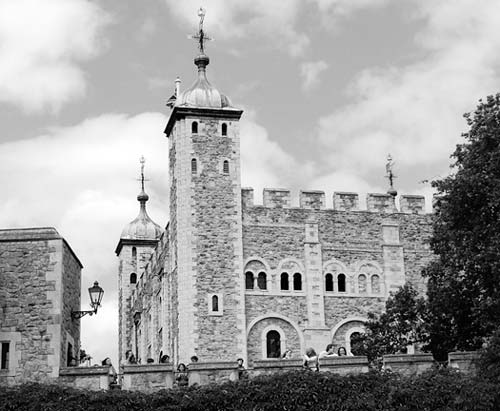
Note that lines can be long for this sight; see here for tips on getting in quickly. After your visit, consider taking the boat to Greenwich from here (see cruise info on here ).
Cost and Hours: £25, family-£63; Tue-Sat 9:00-17:30, Sun-Mon 10:00-17:30; Nov-Feb closes one hour earlier; free Beefeater tours available, skippable audioguide-£4, Tube: Tower Hill, tel. 0844-482-7788, www.hrp.org.uk .
 See the Tower of London Tour chapter.
See the Tower of London Tour chapter.
The iconic Tower Bridge (often mistakenly called London Bridge) has been recently painted and restored. The hydraulically powered drawbridge was built in 1894 to accommodate the growing East End. While fully modern, its design was a retro Neo-Gothic look.
The bridge is most interesting when the drawbridge lifts to let ships pass, as it does a thousand times a year (best viewed from the Tower side of the Thames). For the bridge-lifting schedule, check the website or call.
You can tour the bridge at the Tower Bridge Exhibition, with a history display and a peek at the Victorian engine room that lifts the span. Included in your entrance is the chance to cross the bridge—138 feet above the road along a partially see-through glass walkway. As an exhibit, it’s overpriced, though the adrenaline rush and spectacular city views from the walkway may help justify the cost.
Cost and Hours: £9, £11 combo-ticket with Monument, credit cards accepted, daily 10:00-18:00 in summer, 9:30-17:30 in winter, enter at northwest tower, Tube: Tower Hill, tel. 020/7403-3761, www.towerbridge.org.uk .
Nearby: The best remaining bit of London’s Roman Wall is just north of the Tower (at the Tower Hill Tube station). The chic St. Katharine Dock, just east of Tower Bridge, has private yachts and mod shops. Across the bridge, on the South Bank, is the upscale Butlers Wharf area, as well as City Hall, museums, the Jubilee Walkway, and, towering overhead, the Shard. Or you can head north to Liverpool Street Station and follow my “East End Walk.”
Every great city needs an “East End”—the downwind-from-industry, poor workers’ quarter where rents are cheap, immigrants with different religions and customs can find comfort in numbers, and the everyday people who power the economic engine of that city find a humble home.
London’s East End has a long history as the city’s poorer side of town—even in medieval times, this was the less desirable end, in part because it was downwind from the noxious hide-tanning district. London’s east/west disparity was exacerbated in Victorian times, when the wind carried the pollution of a newly industrialized London. These days, there’s a new energy here, and it’s well worth exploring.
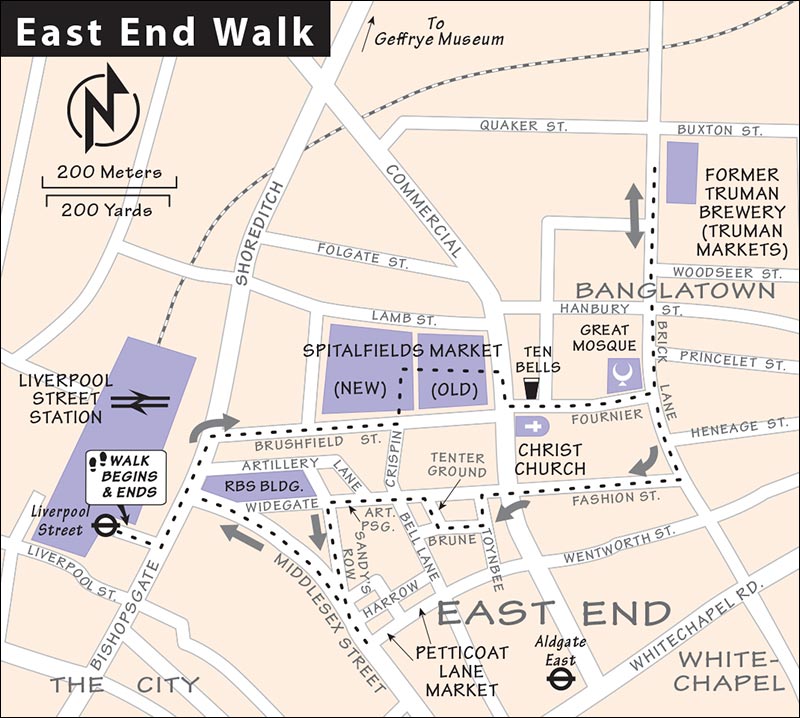
(See "East End Walk" map, here .)
This walk—which takes about an hour without stopping to slurp a curry or shop the markets—is basically a big rectangle. Liverpool Street Station marks the end of The City—everything beyond is “East End.” From Bishopsgate we’ll walk down Brushfield Street (dip into Spitalfields Market and visit Christ Church along the way) to Brick Lane (the “Banglatown” Bangladeshi neighborhood), then return to Liverpool Street Station through some characteristic Jack-the-Ripper-type lanes and the Petticoat Lane Market. The walk works best on Sunday afternoons, when the Spitalfields, Petticoat Lane, and Truman markets thrive (for more on these markets, see here ). With a buffet of tempting eateries along or near our route, you could turn this walk into a progressive meal, sampling whatever looks good before sitting down to a main course at the end...if you’re still hungry (for recommended eateries, see here ).
Getting There: Ride the Tube to Liverpool Street, and head into the train station. Exit the busy station through the Bishopsgate exit (facing the train tracks, it’s on the far end to your right, up the stairs/escalators).
 Self-Guided Walk:
Outside the train station, cross Bishopsgate Street and turn left. Continue two blocks ahead to the glassy, modern RBS building, then turn right on Brushfield Street; from here you can see the steeple of Christ Church. The first third of this
walk is basically a straight line from here to Brick Lane (with stops at Spitalfields Market and Christ Church). Head for the church, but half a block or so before you get there, detour left into the market.
Self-Guided Walk:
Outside the train station, cross Bishopsgate Street and turn left. Continue two blocks ahead to the glassy, modern RBS building, then turn right on Brushfield Street; from here you can see the steeple of Christ Church. The first third of this
walk is basically a straight line from here to Brick Lane (with stops at Spitalfields Market and Christ Church). Head for the church, but half a block or so before you get there, detour left into the market.
Spitalfields Market: This lively, inviting, modern-feeling market hall boasts a combination of colorful restaurants, shops, and—on many days—market stalls selling upscale crafts, designer clothes, collectables, and vintage curiosities. Like so many markets, it’s liveliest on Sunday (dating back to when it was a Jewish market closed Saturday for the Sabbath). Exit the market through the “Spitfire” gate at the east end and head for the big church on the right.
Christ Church and Fournier Street: This stony church, with its towering 225-foot steeple, has a mysterious heritage. Many find occult symbolism in its curious design (without a cross on top). It also evokes London’s most famous serial killer, as many Jack the Ripper witnesses could help pinpoint the time of the crimes by remembering the church bells’ chimes.
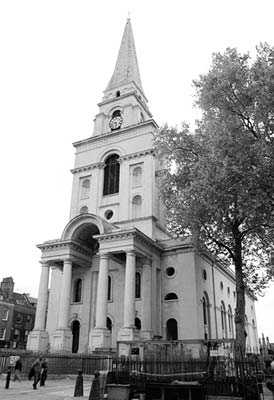
The interior of the church dates to 1711. That’s when Queen Anne decided to build a place for the “God-less thousands who had no place to worship”—meaning to give immigrants a proper Protestant place to worship. It’s stripped down to suit Protestant tastes (but the fine 19th-century windows were added during the “Romantic Age”).
The Ten Bells is just across Fournier Street from the church (on the corner of busy Commercial Street and Fournier Street). This classic working-class pub, established in 1753, was the hangout of one of Jack the Ripper’s victims.
It makes sense that there were lots of watering holes in this neighborhood because pubs have always filled a need for the working class. A beer on the corner was the closest humble workers could get to a comfortable living room, a place to entertain, and a vacation.
This neighborhood is in transition—a battle zone between the 19th century and the 21st century. One way to confront economic hard times is to build. London is building itself out of the Great Recession with a frenzy, and all the construction is threatening characteristic old neighborhoods like this one. The East End Preservation Society is working overtime to protect and preserve the Spitalfields area.
Continue walking east (between the pub and the church) down Fournier Street, which is lined with classic brick tenement houses (though “tenement” now carries a negative connotation, it originally just described any urban apartment building). In the 1700s, Fournier Street was home to lots of Huguenots—French-Protestant religious refugees—who settled here as weavers. With the old lampposts and few signs of modern life, it’s not hard to imagine how this gaslit street would have looked on a foggy night in Jack the Ripper’s time. This long line of former weaving houses leads to Brick Lane and London’s Bangladeshi neighborhood. Walk to the end of the street, marked by the modern metal minaret of a mosque.
Bangladeshi Town and Brick Lane: When you reach Brick Lane, you’re suddenly immersed in “Banglatown,” London’s highest concentration of Bangladeshi residents. Immediately on your left is the neighborhood mosque, Jamme Masjid. This building has a history as dynamic as London itself: It was built as a Huguenot chapel and then used as a Methodist chapel and a Jewish synagogue before being converted into a mosque in 1976.
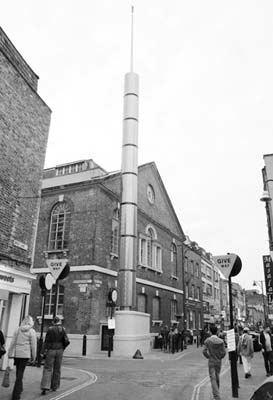
Brick Lane stretches right and left. We’ll venture left a block or so, and then head right a couple blocks before turning right again and returning to Liverpool Street Station.
Even back in ancient Roman times, London’s bricks were made here, on Brick Lane. As mentioned, this gritty workers’ quarter is the engine of a great city (every city needs one). It was once Jewish, then French, now Bangladeshi. That pattern is now in jeopardy: Listen to the sound of construction over the cacophony of languages.
Wander left up Brick Lane, window-shopping for your next course. Here in “the curry capital of Europe,” neon signs advertise cheap specials, awards for “best,” “master,” and “champion” hang from the windows, and out front, pitchmen jockey for your business. The slightest hesitation on your part will result in an offer of a 20 percent discount. This is a great place to sample “Ruby Murray” (Cockney rhyming slang for “curry”—see here ). Just like the US has “Tex-Mex,” England has “Balti,” a British-invented “Indian food” that suits English tastes. After all, chicken tikka masala has replaced fish-and-chips as the national dish.
After two blocks is the former Truman Brewery. The brewery, established in 1666, now houses the Truman Markets —a collection of eclectic markets and funky shops, a creative and colorful food hall, and a food-truck courtyard framed by famous works of street art. A half-block farther north, you’ll find the old brewery smokestack. This is the epicenter of a youthful, trendy scene with several lively pub/café/nightclubs.
Now turn around and backtrack south on Brick Lane, passing the mosque at Fournier Street (where you entered this street).
Jack the Ripper Streets: Continue down Brick Lane another block and turn right (west) on Fashion Street. When you hit busy Commercial Street, cross it, go a few steps, and then veer left on Toynbee Street—past a hair salon called “Jack the Clipper.” Then head right on Brune Street, where you’ll see more Industrial Age tenements and the “Soup Kitchen for the Jewish Poor” (sign above the doorways on right, at #9). At the end of the block, turn right onto Tenter Ground, the street where weavers once dried cloth “on tenterhooks,” giving us the phrase that means “uneasy.” Look up to see the iron racks still rigged to the building.
At the end of Tenter Ground, look across Crispin Street for a big building with a “Women” sign. This is the women’s entrance to a Victorian workhouse. Cross Crispin/Bell Lane and walk down narrow Artillery Lane. Notice the men’s entrance to the same workhouse above you on the right. The name of this street dates to around 1500, when Henry VIII used this as a practice zone for his artillery.
Artillery Lane soon shrinks to become atmospheric Artillery Passage, lined with tiny eateries—giving you an idea of how densely packed this neighborhood was when it was filled with grimy-faced 19th-century factory workers. Jack the Ripper films always use this characteristic street.
At the intersection with Sandy’s Row are the bollards (black-white-red stakes in the pavement), alerting you that you’re officially leaving the East End and entering the City of London. (You could end the walk here by continuing straight ahead to Liverpool Street Station.)
Petticoat Lane Market: For a side-trip to Petticoat Lane Market, turn left. Go three blocks (down Sandy’s Row and then Middlesex Street) to Wentworth Street, which leads left into the market. One of the oldest markets in Britain, this one has existed here for 400 years selling cheap stuff for poor working people. It’s fun daily and packed on Sunday; enticing food stalls line Goulston Street.
Return to Liverpool Street Station by following Middlesex Street back to your starting point. Middlesex is the border between The City (on your left) and the East End (on your right). Consider again the juxtaposition of these two equally characteristic parts of London: The City, also called “One Square Mile,” is the richest square mile on earth. This banking district towers like a rich monster while far below, in the East End, people scrummage for “pants, 3 for a tenner.”
Back at the Liverpool Street train and Tube stations, take a moment to recall the reason you don’t see many garbage cans—and you can’t check a bag at the station. At 8:45 on July 7, 2005, a Tube train had just pulled out of Liverpool Street Station when it was rocked by a terrorist bomb—the first of four to hit London that day. But the next day, Londoners were back on the Tube.
This low-key but well-organized museum—housed in an 18th-century almshouse—is located north of Liverpool Street Station. It’s a strip of 11 rooms, each furnished as a living room from a different age and each very well-described. It’s an intimate peek at the middle class as its comforts evolved from 1600 to 2000. In summer, explore the fragrant herb garden.
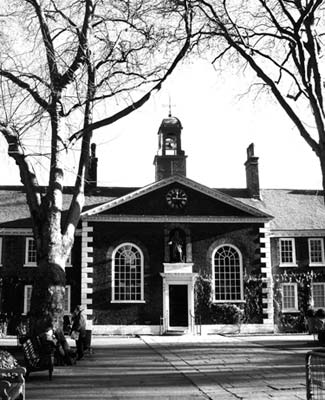
Cost and Hours: Free, £3 suggested donation, Tue-Sun 10:00-17:00, closed Mon, garden open April-Oct, 136 Kingsland Road, tel. 020/7739-9893, www.geffrye-museum.org.uk .
Getting There: Take the Tube to Liverpool Street, then ride the bus 10 minutes north (bus #149 or #242—leave station through Bishopsgate exit and head left a few steps to find stop; hop off at the Pearson Street stop, just after passing the brick museum on the right). Or take the East London line on the Overground to the Hoxton stop, which is right next to the museum (Tube tickets and Oyster cards also valid on Overground).
The South Bank of the Thames is a thriving arts and cultural center, tied together by the riverfront Jubilee Walkway.
This riverside path is a popular pub-crawling pedestrian promenade that stretches all along the South Bank, offering grand views of the Houses of Parliament and St. Paul’s. On a sunny day, this is the place to see Londoners out strolling. The Walkway hugs the river except just east of London Bridge, where it cuts inland for a couple of blocks. It has been expanded into a 60-mile “Greenway” circling the city, including the 2012 Olympics site.
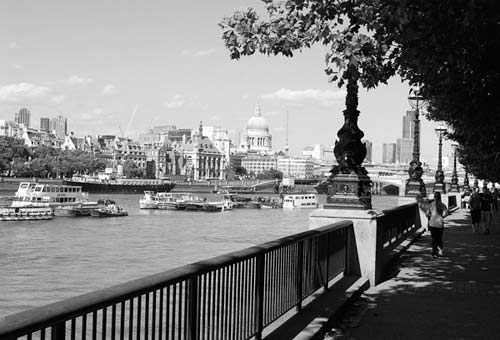
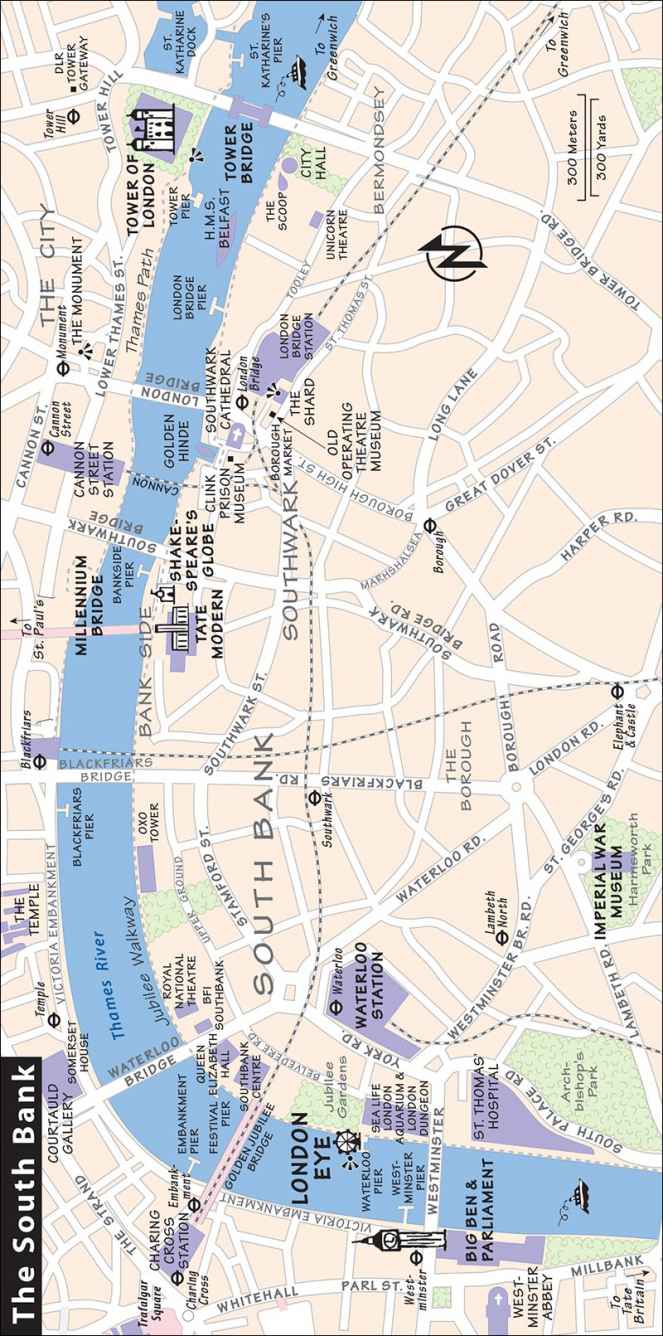
This giant Ferris wheel, towering above London opposite Big Ben, is one of the world’s highest observational wheels and London’s answer to the Eiffel Tower. Riding it is a memorable experience, even though London doesn’t have much of a skyline, and the price is borderline outrageous. Whether you ride or not, the wheel is a sight to behold.
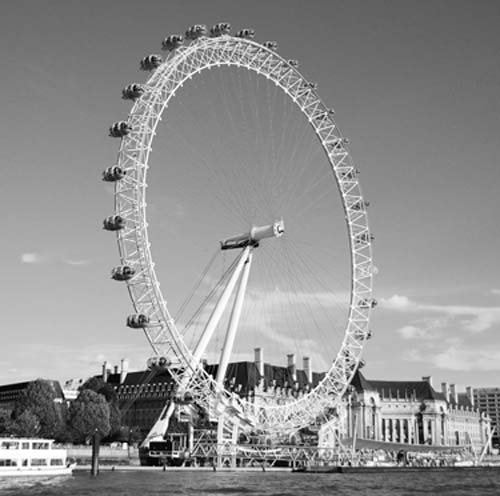
Designed like a giant bicycle wheel, it’s a pan-European undertaking: British steel and Dutch engineering, with Czech, German, French, and Italian mechanical parts. It’s also very “green,” running extremely efficiently and virtually silently. Twenty-five people ride in each of its 32 air-conditioned capsules (representing the boroughs of London) for the 30-minute rotation (you go around only once). From the top of this 443-foot-high wheel—the second-highest public viewpoint in the city—even Big Ben looks small. Built to celebrate the new millennium, the Eye has become a permanent fixture on the London skyline.
After buying your ticket inside, you’ll be aggressively ushered into the London Eye 4-D Experience, a brief (four-minute) and engaging show combining a 3-D movie with wind and water effects. This bombastic ad for the attraction you already bought a ticket for, in some ways, is more exciting than riding the Eye itself. You can politely skip the show if you just want to get on the wheel, and you have the option of coming back after your ride to watch the movie.
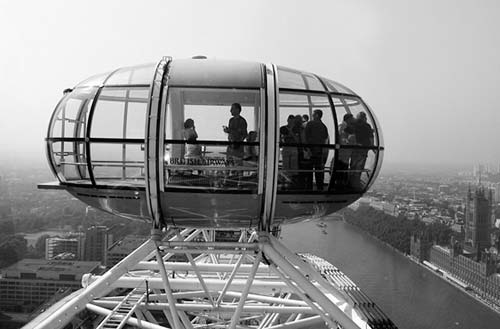
Cost: £24.95, family ticket available (online only), about 10 percent cheaper if bought online. Combo-tickets save money if you plan on visiting Madame Tussauds. Buy tickets in advance at www.londoneye.com , by calling 0870-500-0600, or in person at the box office (in the corner of the County Hall building nearest the Eye).
Hours: Daily 10:00-20:30, until 21:30 or later in July and August, check website for latest schedule, these are last-ascent times, closed Dec 25 and a few days in Jan for maintenance, Tube: Waterloo or Westminster. Thames boats come and go from Waterloo Pier at the foot of the wheel.
Crowd-Beating Tips: The London Eye is busiest between 11:00 and 17:00, especially on weekends year-round and every day in July and August. You may wait up to 30 minutes to buy your ticket, then another 30-45 minutes to board your capsule—it’s best to prebook your ticket during these times. Print your advance ticket at home, retrieve it from an onsite ticket machine (bring your payment card and confirmation code), or stand in the “Ticket Collection” line. Even if you buy in advance, you still have to wait a bit to board the wheel. You can pay an extra £8 for a Fast Track ticket that lets you jump the queue, but it’s probably not worth the expense.
By the Eye: The area next to the London Eye has developed a cotton-candy ambience of kitschy, kid-friendly attractions. There’s a game arcade, an aquarium, and the Shrek’s Adventure amusement ride.
This impressive museum covers the wars of the last century—from World War I biplanes, to the rise of fascism, the Cold War, the Cuban Missile Crisis, the Troubles in Northern Ireland, the wars in Iraq and Afghanistan, and terrorism. Rather than glorify war, the museum encourages an understanding of the history of modern warfare and the wartime experience, including the effect it has on the everyday lives of people back home. The museum’s coverage never neglects the human side of one of civilization’s more uncivilized, persistent traits.
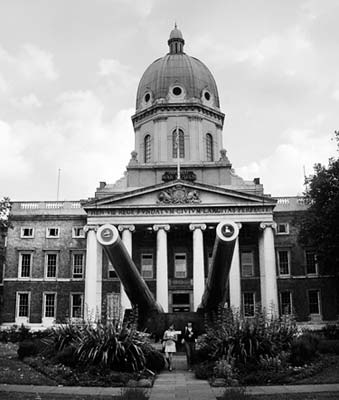
Allow plenty of time, as this powerful museum—with lots of artifacts and video clips—can be engrossing. The highlights are the new WWI galleries (renovated to commemorate the 100-year anniversary of that conflict) and the WWII area, the “Secret War” section, and the Holocaust exhibit. War wonks love the place, as do general history buffs who enjoy patiently reading displays. For the rest, there are enough interactive experiences and multimedia exhibits and submarines for the kids to climb in to keep it interesting.
The museum (which sits in an inviting park equipped with an equally inviting café) is housed in what had been the Royal Bethlam Hospital. Also known as “the Bedlam asylum,” the place was so wild that it gave the world a new word for chaos. Back in Victorian times, locals—without reality shows and YouTube—paid admission to visit the asylum on weekends for entertainment.
Cost and Hours: Free, £5 suggested donation, daily 10:00-18:00, special exhibits extra, various free audioguides may be available—ask at the info desk, Tube: Lambeth North or Elephant and Castle; buses #3, #12, and #159 come here from Westminster area; tel. 020/7416-5000, www.iwm.org.uk .
Visiting the Museum: Start with the atrium to grasp the massive scale of warfare as you wander among and under notable battle machines, then head directly for the museum’s latest pride and joy: the recently renovated WWI galleries. Here firsthand accounts connect the blunt reality of a brutal war with the contributions, heartache, and efforts of a nation. Exhibits cover the various theaters and war at sea, as well as life on the home front.
As you escape unscathed, pause to ponder the irony of how different this museum would be if the war to end all wars had lived up to its name. Instead, the museum, much like history, builds on itself. Ascending to the first floor, you’ll find the permanent Turning Points galleries progressing up to and through World War II and including sections explaining the Blitzkrieg and its effects (see an actual Nazi parachute bomb like the ones that devastated London). For a deeper understanding of life during these decades, visit the Family in Wartime exhibit to see London through the eyes of an ordinary family.
The second floor houses the Secret War exhibit, which peeks into the intrigues of espionage in World Wars I and II through present-day security. You’ll learn about MI5 (Britain’s domestic spy corps), MI6 (their international spies—like the CIA), and the Special Operations Executive (SOE), who led espionage efforts during World War II. The exhibit features actual surveillance equipment and poses challenging questions about the role of secrecy in government.
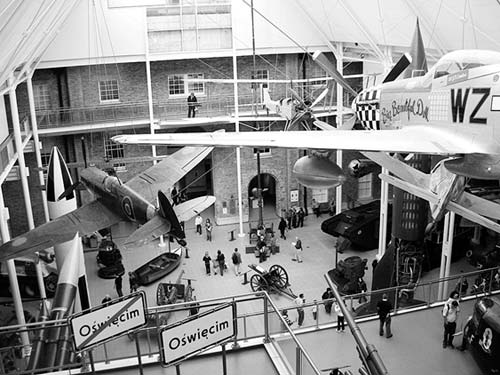
The third floor houses various (and often rotating) temporary art and film exhibits speckled with military-themed works including John Singer Sargent ’s Gassed (1919), showing besieged troops in World War I, and other giant canvases.
The fourth-floor section on the Holocaust, one of the best on the subject anywhere, tells the story with powerful videos, artifacts, and fine explanations. While it’s not the same as actually being at one of Europe’s many powerful Holocaust sites, the exhibits are compelling enough to evoke the same emotions.
Crowning the museum on the fifth floor is the Lord Ashcroft Gallery and the Extraordinary Heroes display. Here, more than 250 stories celebrate Britain’s highest military award for bravery with the world’s largest collection of Victoria Cross medals. Civilians who earned the George Cross medal for bravery are also honored.
These sights are in Southwark (SUTH-uck), the core of the tourist’s South Bank. Southwark was for centuries the place Londoners would go to escape the rules and decency of the city and let their hair down. Bearbaiting, brothels, rollicking pubs, and theater—you name the dream, and it could be fulfilled just across the Thames. A run-down warehouse district through the 20th century, it’s been gentrified with classy restaurants, office parks, pedestrian promenades, major sights (such as the Tate Modern and Shakespeare’s Globe), and a colorful collection of lesser sights. The area is easy on foot and a scenic—though circuitous—way to connect the Tower of London with St. Paul’s.
 You’ll find more information on these sights in the Bankside Walk chapter.
You’ll find more information on these sights in the Bankside Walk chapter.
Dedicated in the spring of 2000, the striking museum fills a derelict old power station across the river from St. Paul’s—it opened the new century with art from the previous one. Its powerhouse collection includes Dalí, Picasso, Warhol, and much more. Of equal interest are the many temporary exhibits featuring more current, cutting-edge art. Each year, the main hall features a different monumental installation by a prominent artist.
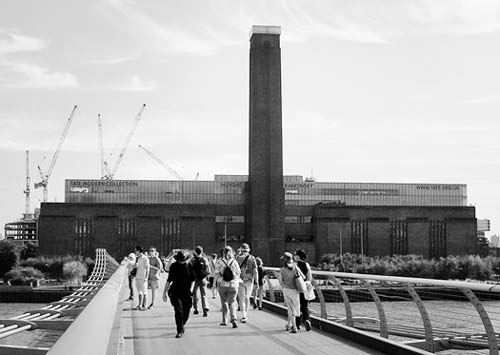
Cost and Hours: Free, £4 donation appreciated, fee for special exhibitions; open daily 10:00-18:00, Fri-Sat until 22:00, last entry to special exhibits 45 minutes before closing, especially crowded on weekend days (crowds thin out on Fri and Sat evenings); free guided tours available, videoguide-£4.50, view restaurant on top floor, across the Millennium Bridge from St. Paul’s; Tube: Southwark, London Bridge, St. Paul’s, Mansion House, or Blackfriars plus a 10-15-minute walk; or connect by Tate Boat museum ferry from Tate Britain—see here ; tel. 020/7887-8888, www.tate.org.uk .
 See the Tate Modern Tour chapter.
See the Tate Modern Tour chapter.
The pedestrian bridge links St. Paul’s Cathedral and the Tate Modern across the Thames. This is London’s first new bridge in a century. When it opened, the $25 million bridge wiggled when people walked on it, so it promptly closed for repairs; 20 months and $8 million later, it reopened. Nicknamed the “blade of light” for its sleek minimalist design (370 yards long, four yards wide, stainless steel with teak planks), its clever aerodynamic handrails deflect wind over the heads of pedestrians.
This replica of the original Globe Theatre was built, half-timbered and thatched, as it was in Shakespeare’s time. (This is the first thatched roof constructed in London since they were outlawed after the Great Fire of 1666.) The Globe originally accommodated 2,200 seated and another 1,000 standing. Today, slightly smaller and leaving space for reasonable aisles, the theater holds 800 seated and 600 groundlings.
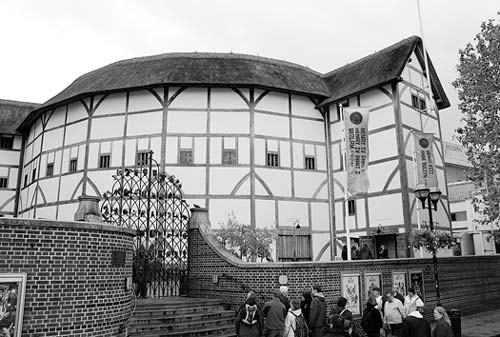
Its promoters brag that the theater melds “the three A’s”—actors, audience, and architecture—with each contributing to the play. The working theater hosts authentic performances of Shakespeare’s plays with actors in period costumes, modern interpretations of his works, and some works by other playwrights.
The Globe complex has four parts: the Globe theater itself, the box office, a museum (called the Exhibition), and the Sam Wanamaker Playhouse (an indoor Jacobean theater around back). The Playhouse, which hosts performances through the winter, is horseshoe-shaped, intimate (seating fewer than 350), and sometimes uses authentic candle-lighting for period performances. The repertoire focuses less on Shakespeare and more on the work of his contemporaries (Jonson, Marlow, Fletcher), as well as concerts. (For details on getting tickets, see here .)
Cost: £15 ticket (good all day) includes Exhibition, audioguide, and 40-minute tour of the Globe; when theater is in use, you can tour the Exhibition only for £6.
Hours: The complex is open daily 9:00-17:30. Tours start every 30 minutes; during Globe theater season (late April-mid-Oct), last tour Mon at 17:00, Tue-Sat at 12:30, Sun at 11:30—it’s safest to arrive for a tour before noon; located on the South Bank over the Millennium Bridge from St. Paul’s, Tube: Mansion House or London Bridge plus a 10-minute walk; tel. 020/7902-1400, box office tel. 020/7401-9919, www.shakespearesglobe.com .
Visiting the Globe: You browse on your own in the Exhibition (with the included audioguide) through displays of Elizabethan-era costumes and makeup, music, script-printing, and special effects (the displays change). There are early folios and objects that were dug up on site. Videos and scale models help put Shakespearean theater within the context of the times. (The Globe opened in 1599, eleven years after England mastered the seas by defeating the Spanish Armada. The debut play was Shakespeare’s Julius Caesar. ) You’ll also learn how they built the replica in modern times, using Elizabethan materials and techniques. Take advantage of the touch screens to delve into specific topics.
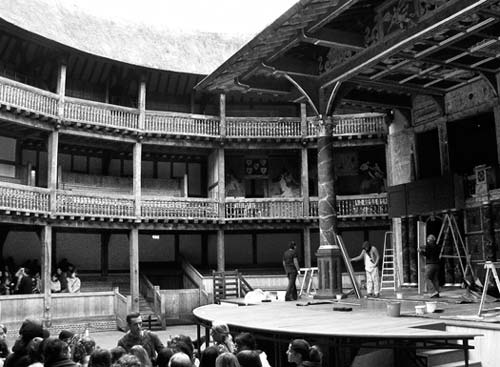
You must tour the theater at the time stamped on your ticket, but you can come back to the Exhibition museum afterward. A guide (usually an actor) leads you into the theater to see the stage and the various seating areas for the different classes of people. You take a seat and learn how the new Globe is similar to the old Globe (open-air performances, standing-room by the stage, no curtain) and how it’s different (female actors today, lights for night performances, concrete floor). It’s not a backstage tour—you don’t see dressing rooms or costume shops or sit in on rehearsals—but the guides are energetic, theatrical, and knowledgeable, bringing the Elizabethan period to life.
Eating: The $$$$ Swan at the Globe café offers a sit-down restaurant (for lunch and dinner, reservations recommended, tel. 020/7928-9444), a drinks-and-plates bar, and a sandwich-and-coffee cart (daily 9:00-closing, depending on performance times).
Proudly the “original clink,” this was, until 1780, where law-abiding citizens threw Southwark troublemakers. Today, it’s a low-tech torture museum filling grotty old rooms with papier-mâché gore. There are storyboards about those unfortunate enough to be thrown in the Clink, but little that seriously deals with the fascinating problem of law and order in Southwark, where 18th-century Londoners went for a good time.
Cost and Hours: Overpriced at £7.50; July-Sept daily 10:00-21:00; Oct-June Mon-Fri 10:00-18:00, Sat-Sun until 19:30; 1 Clink Street, Tube: London Bridge, tel. 020/7403-0900, www.clink.co.uk .
This is a full-size replica of the 16th-century warship in which Sir Francis Drake circumnavigated the globe from 1577 to 1580. Commanding the original ship (now long gone), Drake earned his reputation as history’s most successful pirate. This replica, however, has logged more than 100,000 miles, including a voyage around the world. While the ship is fun to see, its interior is not worth touring.
Cost and Hours: £6, daily 10:00-17:00, Tube: London Bridge, ticket office just up Pickfords Wharf from the ship, tel. 020/7403-0123, www.goldenhinde.com .
While made a cathedral only in 1905, it’s been the neighborhood church since the 13th century, and comes with some interesting history. The enthusiastic docents give impromptu tours if you ask.
Cost and Hours: Free, £4 donation requested, Mon-Fri 8:00-18:00, Sat-Sun 8:30-18:00, guidebook-£4.50, Tube: London Bridge, tel. 020/7367-6700, www.cathedral.southwark.anglican.org .
Music: The cathedral hosts evensong Sun at 15:00, Tue-Fri 17:30, Sat at 16:00; they also host organ recitals Mon at 13:00 and music recitals Tue at 15:15 (call or check website to confirm times of evensong and recitals).
Climb a tight and creaky wooden spiral staircase to a church attic where you’ll find a garret used to dry medicinal herbs, a fascinating exhibit on Victorian surgery, cases of well-described 19th-century medical paraphernalia, and a special look at “anesthesia, the defeat of pain.” Then you stumble upon Britain’s oldest operating theater, where limbs were sawed off way back in 1821. (See here for a full description.)
Cost and Hours: £6.50, borrowable laminated descriptions, daily 10:30-17:00, closed Dec 15-Jan 5, 9a St. Thomas Street, Tube: London Bridge, tel. 020/7188-2679, www.thegarret.org.uk .
Rocketing dramatically 1,020 feet above the south end of the London Bridge, this addition to London’s skyline is by far the tallest building in Western Europe. Designed by Renzo Piano (best known as the co-architect of Paris’ Pompidou Center), the glass-clad pyramid shimmers in the sun and its prickly top glows like the city’s nightlight after dark. Its uppermost floors are set aside as public viewing galleries, but the ticket price is as outrageously high as the building itself, especially given that it’s a bit far from London’s most exciting landmarks. The Aqua Shard bar on the 31st floor offers views from half the height for the price of a fancy drink (free to ride up, but if they’re at capacity they can turn you away, bar open 12:00-24:00; no sportswear, shorts, or flip-flops; access the bar from separate entrance on St. Thomas Street, www.aquashard.co.uk ). For a list of cheaper view opportunities in London, see the sidebar on here .
Cost and Hours: £31 (cheaper if booked online at least a day in advance); book as soon as you have reasonable chance of assuring decent weather, least crowded on weekday mornings, but perhaps better photo opportunities in the early evening (less haze); daily 10:00-22:00, shorter hours Oct-March, last entry one hour before closing; Tube: London Bridge—use London Bridge exit and follow signs, tel. 0844-499-7111, www.theviewfromtheshard.com .
Visiting the Shard: From the entrance on Joiner Street (just off St. Thomas Street) you’ll take a two-part elevator ride up to the 68th floor, then climb up one story to the main observation platform. It’s equipped with cool telescopes that label major landmarks, and even let you see how the view from here would appear at other times of the day. From here you’ve got great views of St. Paul’s, the Tower of London, Southwark Cathedral (straight down), and, in the distance, the 2012 Olympic stadium in one direction, and the Houses of Parliament in the other (find Buckingham Palace, just left of the Eye). On the clearest days, you can see 40 miles out, and a few people say they’ve been able to make out ships on the North Sea. Even in bad weather it’s mesmerizing to watch the constant movement of the city’s transit system, which looks like a model-train set from this height. Ascending to the 72nd floor gets you to the open-air deck, where the wind roars over the glass enclosure. As you look up, try to picture Prince Andrew rappelling off the very top, which he and 40 others did in 2012 as a charity fundraising stunt.
The last big-gun armored warship of World War II clogs the Thames just upstream from the Tower Bridge. This huge vessel—now manned with wax sailors—thrills kids who always dreamed of sitting in a turret shooting off their imaginary guns. If you’re into WWII warships, this is the ultimate. Otherwise, it’s just lots of exercise with a nice view of the Tower Bridge.
Cost and Hours: Adult-£16, kids 5-15-£8, family ticket for 2 adults and up to 3 kids-£42, kids under 5-free, includes audioguide, daily March-Oct 10:00-18:00, Nov-Feb 10:00-17:00, last entry one hour before closing, Tube: London Bridge, tel. 020/7940-6300, www.iwm.org.uk/visits/hms-belfast .
The glassy, egg-shaped building near the south end of Tower Bridge is London’s City Hall, designed by Sir Norman Foster, the architect who worked on London’s Millennium Bridge and Berlin’s Reichstag. Nicknamed “the Armadillo,” City Hall houses the office of London’s mayor—it’s here that the mayor consults with the Assembly representatives of the city’s 25 districts. An interior spiral ramp allows visitors to watch and hear the action below in the Assembly Chamber—ride the lift to floor 2 (the highest visitors can go) and spiral down. On the lower ground floor is a large aerial photograph of London and a handy cafeteria. Next to City Hall is the outdoor amphitheater called The Scoop (see here for info on performances).
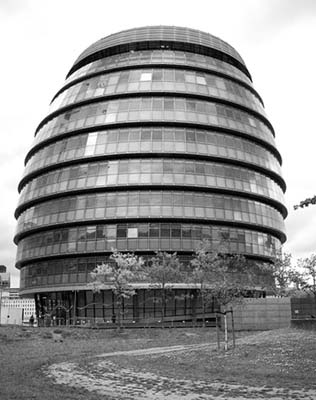
Cost and Hours: Free, open to visitors Mon-Thu 8:30-18:00, Fri 8:30-17:30, closed Sat-Sun; Tube: London Bridge station plus 10-minute walk, or Tower Hill station plus 15-minute walk; tel. 020/7983-4000, www.london.gov.uk .
(See "West London" map, here .)
One of Europe’s great art houses, Tate Britain specializes in British painting from the 16th century through modern times. The recently renovated museum has a good representation of William Blake’s religious sketches, the Pre-Raphaelites’ naturalistic and detailed art, Gainsborough’s aristocratic ladies, and the best collection anywhere of J. M. W. Turner’s swirling works.
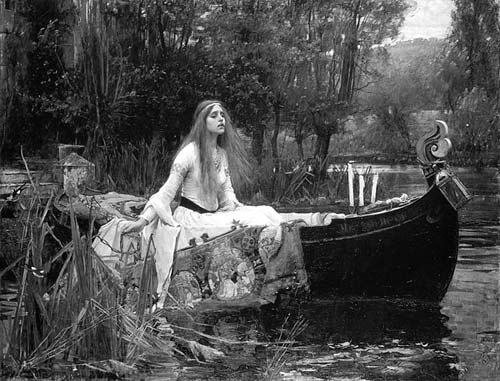
Cost and Hours: Free, £4 donation suggested, admission fee for special exhibits; daily 10:00-18:00, last entry 45 minutes before closing; free tours generally daily; on the Thames River, south of Big Ben and north of Vauxhall Bridge, Tube: Pimlico, Tate Boat museum ferry goes directly to the museum from Tate Modern—see here ; switchboard tel. 020/7887-8888, www.tate.org.uk .
 See the Tate Britain Tour chapter.
See the Tate Britain Tour chapter.
From underneath this station’s iron-and-glass canopy, trains depart for the south of England and Gatwick Airport. While Victoria Station is famous and a major Tube stop, few tourists actually take trains from here—most just come to take in the exciting bustle. It’s a fun place to just be a “rock in a river” teeming with commuters and services. The station is surrounded by big red buses and taxis, travel agencies, and lousy eateries. It’s next to the main intercity bus station (Victoria Coach Station) and the best inexpensive lodgings in town.
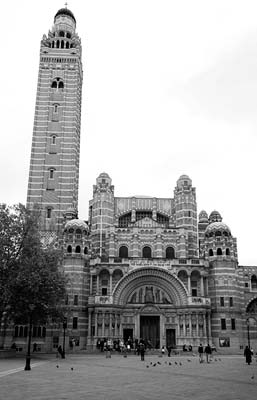
This cathedral, the largest Catholic church in England and just a block from Victoria Station, is strikingly Neo-Byzantine, but not very historic or important to visit. Opened in 1903, the church has an unfinished interior, with a spooky, blackened ceiling waiting for the mosaics that are supposed to be placed there. While it’s definitely not Westminster Abbey, half the tourists wandering around inside seem to think it is. Take the lift to the top of the 273-foot bell tower for a view of the glassy office blocks of Victoria Station.
Cost and Hours: Free entry, £6 for the lift; church—daily 7:00-19:00; tower—daily 9:30-17:00, Sat-Sun until 18:00; 5-minute walk from bus terminus in front of Victoria Station, just off Victoria Street at 42 Francis Street, Tube: Victoria, www.westminstercathedral.org.uk .
This museum—which recently reopened after a complete renovation—tells the story of the British army from 1415 through the Bosnian conflict and Iraq, with lots of Redcoat lore and a good look at Waterloo. Kids enjoy trying on a Cromwellian helmet, seeing the skeleton of Napoleon’s horse, and peering out from a WWI trench through a working periscope.
Cost and Hours: Free, daily 10:00-17:30, Royal Hospital Road, Chelsea, Tube: Sloane Square, tel. 020/7730-0717, www.national-army-museum.ac.uk .
A number of worthwhile sights border this grand park, from Apsley House on the east to Kensington Palace on the west.
Having beaten Napoleon at Waterloo, Arthur Wellesley, the First Duke of Wellington, was once the most famous man in Europe. He was given a huge fortune, with which he purchased London’s ultimate address, Number One London. His refurbished mansion offers a nice interior, a handful of world-class paintings, and a glimpse at the life of the great soldier and two-time prime minister. Those who know something about Wellington ahead of time will appreciate the place much more than those who don’t, as there’s scarce biographical background. The place is well-described by the included audioguide, which has sound bites from the current Duke of Wellington (who still lives at Apsley).
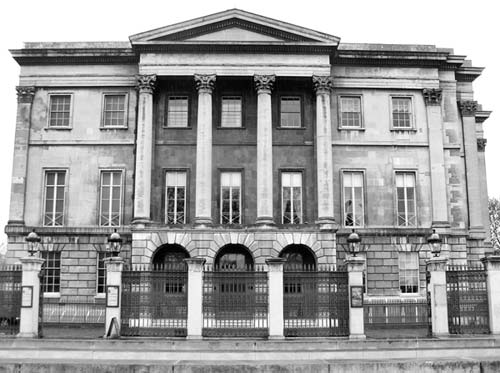
Cost and Hours: £9.70, Wed-Sun 11:00-17:00, closed Mon-Tue, no photos, 20 yards from Hyde Park Corner Tube station, tel. 020/7499-5676, www.english-heritage.org.uk .
Visiting the House: An 11-foot-tall marble statue of Napoleon, clad only in a fig leaf, greets you. Napoleon commissioned the sculptor Canova to make it for him but didn’t like it, and after Napoleon’s defeat, Wellington acquired it as a war trophy. It’s one of several images Wellington acquired of his former foe to have in his home. The two great men were polar opposites—Napoleon the daring general and champion of revolution, Wellington the play-it-safe strategist and conservative politician—but they’re forever linked in history.
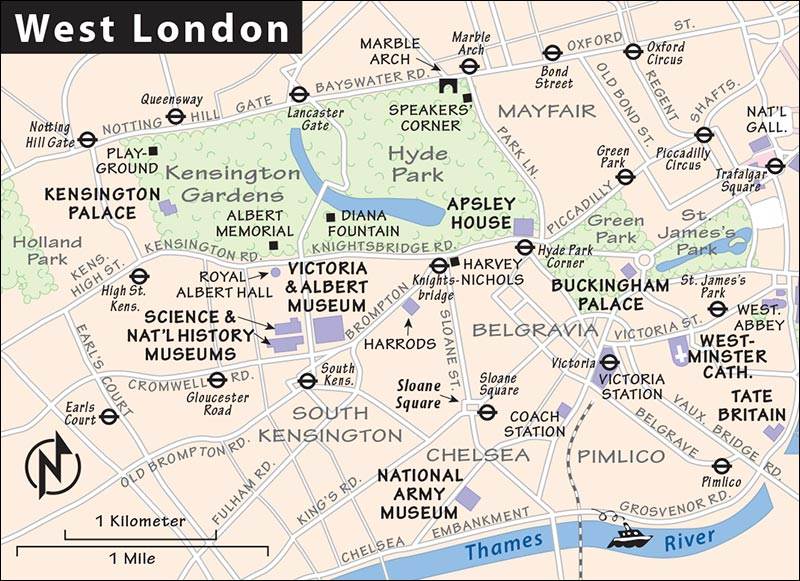
The core of the collection is a dozen first-floor rooms decorated with fancy wallpaper, chandeliers, a few pieces of furniture, and wall-to-wall paintings from Wellington’s collection. You’ll see fancy dinnerware and precious objects given to the Irish-born general by the crowned heads of Europe, who were eternally grateful to him for saving their necks from the guillotine. The highlight is the large ballroom, the Waterloo Gallery, decorated with Anthony van Dyck’s Charles I on Horseback (over the main fireplace), Diego Velázquez’s earthy Water-Seller of Seville (to the left of Van Dyck), Jan Steen’s playful Dissolute Household (to the right). Just outside the door, in the Portico Room, is a large portrait of the Duke of Wellington by Francisco Goya.

Downstairs is a small gallery of Wellington memorabilia, including a pair of Wellington boots, which the duke popularized—Brits today still call rubber boots “wellies” (sometimes on loan to the Wellington Arch, see next page).
Nearby: Hyde Park ’s pleasant rose garden is picnic-friendly. Wellington Arch, which stands just across the street, is open to the public but not worth the £5.20 charge (or £10.50 combo-ticket with Apsley House; elevator up, lousy views and boring exhibits).
London’s “Central Park,” originally Henry VIII’s hunting grounds, has more than 600 acres of lush greenery, Santander Cycles rental stations, the huge man-made Serpentine Lake (with rental boats and a lakeside swimming pool), the royal Kensington Palace (described next), and the ornate Neo-Gothic Albert Memorial across from the Royal Albert Hall (for more about the park, see www.royalparks.org.uk/parks/hyde-park ). The western half of the park is known as Kensington Gardens. The park is huge—study a Tube map to choose the stop nearest to your destination.
On Sundays, from just after noon until early evening, Speakers’ Corner offers soapbox oratory at its best (northeast corner of the park, Tube: Marble Arch). Characters climb their stepladders, wave their flags, pound emphatically on their sandwich boards, and share what they are convinced is their wisdom. Regulars have resident hecklers who know their lines and are always ready with a verbal jab or barb. “The grass roots of democracy” is actually a holdover from when the gallows stood here and the criminal was allowed to say just about anything he wanted to before he swung. I dare you to raise your voice and gather a crowd—it’s easy to do.
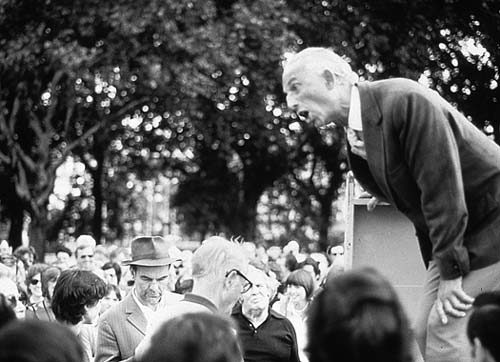
The Princess Diana Memorial Fountain honors the “People’s Princess,” who once lived in nearby Kensington Palace. The low-key circular stream, great for cooling off your feet on a hot day, is in the south-central part of the park, near the Albert Memorial and Serpentine Gallery (Tube: Knightsbridge). A similarly named but different sight, the Diana, Princess of Wales Memorial Playground, in the park’s northwest corner, is loads of fun for kids (Tube: Queensway).

For nearly 150 years (1689-1837), Kensington was the royal residence, before Buckingham Palace became the official home of the monarch. Sitting primly on its pleasant parkside grounds, the palace gives a barren (especially if the King’s State Apartments are closed for renovation when you visit) yet regal glimpse into royal life—particularly that of Queen Victoria, who was born and raised here. It’s strange to think that, in this city that was so shaped by Victoria, this relatively paltry exhibit is London’s first and only museum that’s truly about Victoria. (For more on Victoria’s life and times, see the sidebar on here .)
After Queen Victoria moved the monarchy to Buckingham Palace, lesser royals bedded down at Kensington. Princess Diana lived here both during and after her marriage to Prince Charles (1981-1997). More recently, Will and Kate moved into a thoroughly renovated Apartment 1A (the southern flank of the palace complex, with four stories and 20 rooms). And Prince Harry lives in their old digs, a “cottage” on the other side of the main building. However—as many disappointed visitors discover—none of these more recent apartments are open to the public.
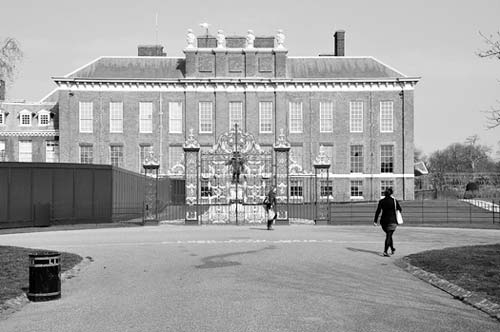
Cost and Hours: £18, daily 10:00-18:00, Nov-Feb until 17:00, last entry one hour before closing, least crowded in mornings; book online in advance to save a few pounds; £5 guidebook but friendly and knowledgeable “explainers” answer questions for free, cloakroom accepts bags and luggage; a long 10-minute stroll through Kensington Gardens from either High Street Kensington or Queensway Tube stations, tel. 0844-482-7788, www.hrp.org.uk .
 Self-Guided Tour:
Before entering the building, notice the statue of Queen Victoria facing Hyde Park and welcoming you to her birth palace. After buying your ticket, head through the foyer into the vestibule with the circular couch. This humble spot is the hub for visitors: From here, you can reach any of the three main exhibits. To see them chronologically, head to the right, pass through a long hallway, and go up the stairs to start with the...
Self-Guided Tour:
Before entering the building, notice the statue of Queen Victoria facing Hyde Park and welcoming you to her birth palace. After buying your ticket, head through the foyer into the vestibule with the circular couch. This humble spot is the hub for visitors: From here, you can reach any of the three main exhibits. To see them chronologically, head to the right, pass through a long hallway, and go up the stairs to start with the...
Queen’s State Apartments: In 1689 an optimistic England welcomed King William, a Protestant from the Netherlands, to take the throne with his English-born wife, Queen Mary. Almost immediately, William hired Sir Christopher Wren to build this new palace in what was then the peaceful village of Kensington as an escape from grimy central London. William moved the royal residence from Whitehall to what became Kensington Palace. These next few rooms focus on the palace’s first royal resident: Queen Mary. Entering the queen’s gallery, you get a sense of the grandeur of the palace—the dances and banquets held here, with expansive views over gardens landscaped in the Dutch style. When it wasn’t used for entertaining, this was simply the queen’s living room, used for everyday activities.
Parliament had recently overthrown the Catholic King James II in the “Glorious Revolution,” and William and Mary represented a new, more democratic start—they were even crowned as joint monarchs. But things would not end well. As you head into the queen’s closet, you’ll read about Mary’s impending death from smallpox. When Mary died—childless—she was eventually succeeded by her sister, Anne. After many failed pregnancies, Queen Anne finally had one child who survived. But on his 11th birthday, he danced so heartily that he came down with a fever and dropped dead. Who would rule after Anne?
Pass through the dining room, where William and Mary enjoyed meals in private, and the drawing room, where Mary kept her collection of porcelain, into the last room, the queen’s bedroom, where the plan of succession of would-be kings and queens is explained. Parliament solved the dilemma by inviting the German-born Hanover dynasty (the “King Georges”)—whose apartments we see next.
• Retrace your steps back down to the vestibule hall, then up the grand King’s Staircase to the...
King’s State Apartment: After climbing the staircase (with its colorful murals of courtiers gazing down at you), you enter the presence chamber, where the king would receive visitors on a raised throne. Even when the throne was empty, visitors had to bow—and exit the room backward. Any respectably-dressed subject could enter the presence chamber, but only those with the proper social status made it beyond here. The next rooms showcase Georgian court life during the palace’s heyday. In the 1700s—not unlike today—it was all about who you knew. The more noble your position, the farther into the palace you were admitted. Weave your way through the next series of rooms as if you were a duke. Imagine the parties, music, card games, and dances that took place here, attended by high society’s wits and intellectuals. In the privy chamber, Queen Caroline, wife of King George IV, once received Isaac Newton, whose bust is one of the heads lining the wall (along with John Locke, Samuel Clark, and others). The clock in middle of the cupola room was extravagantly larger than life. It served as a conversation piece and played Handel at the top of each hour. If you made it as far as the drawing room you were a major player—both in cards and politics. If you were really lucky, you’d win enough money to pay for a lady’s mantua dress—like the original one in far adjacent room—which cost a meager £70,000. Rounding out the apartments, the large king’s gallery ends the visit with paintings by Tintoretto (Esther Before Ahaserus) and Veronese (Adoration of the Kings).
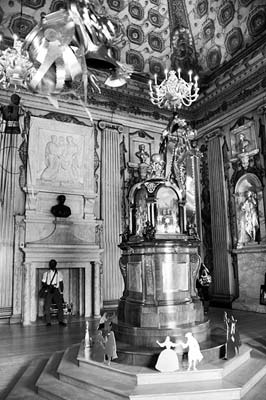
• Now head back downstairs to the vestibule, and up the stone stairs to the third main exhibit...
Victoria Revealed: The artifacts here tell the story of Queen Victoria’s life, displayed in the rooms where she grew up. As Victoria was an avid journal-keeper, you’ll see many excerpts from her own accounts.
The Red Saloon re-creates the day in 1837 when she ascended the throne and the first meeting with her Privy Council. You see the dress the 4’11,” 18-year-old monarch wore. A painting on the wall shows the young queen facing down a room full of nobility assigned to advise her. Standing at the far right end of the table, find Robert “Bobbie” Peel, who’s credited with starting the first professional police force—the “bobbies.” As you can see from the painting, the meeting took place in this very room.
The next room commemorates Victoria’s marriage to her beloved Prince Albert (see their portraits). The carpets, mirrors, and screen are decorated with passages from their love letters, and Victoria’s wedding gown is on display (she began the fashion of brides wearing white). The room to the left is where, most likely, Victoria was born. It has objects from her own childhood (such as her original doll collection) and portraits of her nine children. Continue on through two rooms to a room that celebrates Prince Albert’s Great Exhibition of 1851. Its centerpiece was the Crystal Palace—the wonder of its age—that once stood in the park just in front of you.
The next rooms, shrouded in dark, recall Albert’s sudden and tragic death from typhoid fever: You see the heart-shaped locket that holds a lock of Albert’s hair. Victoria would dress in black for the rest of her life. She lived to be 82, and you can watch footage of her Diamond Jubilee celebration (marking 60 years as reigning monarch from 1837 to 1897). Finally, the exhibit ends with an eclectic collection of items belonging to the royal couple, including Albert’s dressing case (with his tongue scraper), and Victoria’s watercolor box and Transylvanian jewelry.
Outside: Garden enthusiasts enjoy popping into the secluded Sunken Garden, 50 yards from the exit. Consider afternoon tea at the nearby Orangery (see here ), built as a greenhouse for Queen Anne in 1704. On the south side of the palace are the golden gates that became famous in 1997 as the backdrop to the sea of flowers left here by Princess Diana’s mourners.
The world’s top collection of decorative arts encompasses 2,000 years of art and design (ceramics, stained glass, fine furniture, clothing, jewelry, carpets, and more), displaying a surprisingly interesting and diverse assortment of crafts from the West, as well as Asian and Islamic cultures. There’s much to see, including Raphael’s tapestry cartoons, five of Leonardo da Vinci’s notebooks, the huge Islamic Ardabil Carpet (4,914 knots in every 10 square centimeters), a cast of Trajan’s Column that depicts the emperor’s conquests, and pop culture memorabilia, including the jumpsuit Mick Jagger wore for the Rolling Stones’ 1972 world tour.
Cost and Hours: Free, £5 donation requested, extra for some special exhibits, daily 10:00-17:45, some galleries open Fri until 22:00, free tours daily, on Cromwell Road in South Kensington, Tube: South Kensington, from the Tube station a long tunnel leads directly to museum, tel. 020/7942-2000, www.vam.ac.uk .
 See the Victoria and Albert Museum Tour chapter.
See the Victoria and Albert Museum Tour chapter.
Across the street from the Victoria and Albert, this mammoth museum is housed in a giant and wonderful Victorian, Neo-Romanesque building. It was built in the 1870s specifically for the huge collection (50 million specimens). Exhibits are wonderfully explained, with lots of creative, interactive displays. It covers everything from life (“creepy crawlies,” human biology, our place in evolution, and awe-inspiring dinosaurs) to earth science (meteors, volcanoes, and earthquakes).
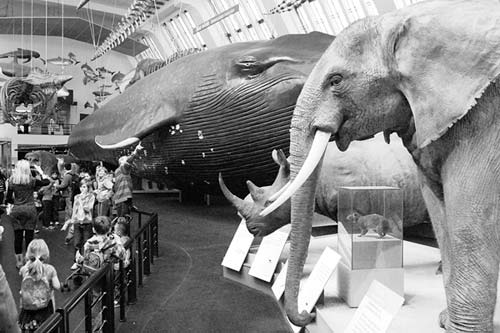
Cost and Hours: Free, £5 donation requested, fees for (optional) special exhibits, daily 10:00-18:00, helpful £1 map, open later last Fri of the month, long tunnel leads directly from South Kensington Tube station to museum (follow signs), tel. 020/7942-5000, exhibit info and reservations tel. 020/7942-5011, www.nhm.ac.uk . Free visitor app available via the “Visit” section of the website.
Visiting the Museum: Enter by the main Cromwell Road entrance (in the middle of the long building), which is easiest for getting oriented. You step into Hintze Hall, with a big Diplodocus skeleton (if it’s on loan, a blue whale will greet you instead) bookended by a massive slice of sequoia tree and Charles Darwin sitting as if upon a throne overseeing it all. Review the “What’s on Today” board for special events and tours, and note which sections are closed. For more information, ask one of the many helpful guards scattered throughout the museum.
The building is organized into several color-coded “zones.” The Blue Zone (to the left) has the biggest animals and biggest crowds: dinosaurs (may have a line), a life-size blue whale model (if it isn’t subbing for the Diplodocus ), and other stuffed-and-mounted mammals.
Straight ahead, up the stairs behind Darwin, is the Cadogan Treasures Gallery, housing a rotating display of the museum’s greatest hits, including a dodo skeleton, moon rock, stuffed specimen of the extinct great auk, fossil of the earliest known bird (Archaeopteryx), and the Iguanodon tooth that kicked off human awareness of dinosaurs.
To the right is the Green Zone, tracing the evolution of the earth and its creatures. Don’t miss a room called “The Vault” that contains rare and precious stones, including a meteorite from Mars, the Aurora Pyramid of Hope—displaying 296 diamonds showing their full range of natural colors—and this description of some microscopic cosmic diamonds: “These are the oldest things you will ever see.”
Keep exploring. The Orange Zone (far left) lets you see today’s scientists at work in their labs. In the Red Zone (far right), you can ride a dramatic escalator up one floor to experience an earthquake.
Even with limited time to spend here, pop in, if only for the dinosaur collection—including a realistic animatronic T. rex —and to hear English children exclaim, “Oh, my goodness!”
Next door to the Natural History Museum, this sprawling wonderland for curious minds is kid-perfect, with themes such as measuring time, exploring space, climate change, the evolution of modern medicine, and the Information Age. It offers hands-on fun, from moonwalks to deep-sea exploration, with trendy technology exhibits, a state-of-the-art IMAX theater (shows-£11, £9 for kids, £27/£30 for families of 3 or 4), and the Garden, a cool play area for children up to age seven.
Cost and Hours: Free, £5 donation requested, daily 10:00-18:00, until 19:00 during school holidays, last entry 45 minutes before closing, Exhibition Road, Tube: South Kensington, tel. 0870-870-4868, www.sciencemuseum.org.uk .
This borough of London—an easy boat trip or DLR (light rail) journey from downtown—combines majestic, picnic-perfect parks; the stately trappings of Britain’s proud nautical heritage (the restored Cutty Sark clipper, the over-the-top-ornate retirement home for sailors at the Old Royal Naval College, and the comprehensive National Maritime Museum ); and the Royal Observatory Greenwich, with a fine museum on the evolution of seafaring and a chance to straddle the eastern and western hemispheres at the prime meridian. An affordable jaunt from central London, and boasting several top-notch museums (including some free ones), Greenwich is worth considering and easy to combine with a look at the Docklands (described next).
 See the Greenwich Tour chapter.
See the Greenwich Tour chapter.
Once the primary harbor for the Port of London, the Docklands has been transformed into a vibrant business center, with ultra-tall skyscrapers, subterranean supermalls, trendy pubs, and peaceful parks with pedestrian bridges looping over canals. It also boasts the very good Museum of London Docklands, which illuminates the gritty and fascinating history of the port. While not full of the touristy sights that many are seeking in London, the Docklands offers a refreshing look at the British version of a 21st-century city. It’s best at the end of the workday, when it’s lively with office workers. It’s ideal to see on your way back from Greenwich, since both line up on the same train tracks.
 See The Docklands Walk chapter.
See The Docklands Walk chapter.
London refashioned this park—the biggest new park to open in the city in a century—from the site of the 2012 Olympic Games. You’ll find miles of parkland trails and waterways, kids’ play areas, an array of sporting venues (London Aquatics Centre, Lee Valley VeloPark, Copper Box Arena), quirky sculpture, and places to eat. The park is huge—bigger than Hyde Park/Kensington Gardens. It’s also quite beautiful, laced with canals and tributaries of the Lea River.
Cost and Hours: Free and always open, toll-free tel. 0800-0722-110, www.queenelizabetholympicpark.co.uk .
Getting There: From central London by Tube, it’s a 30-minute ride to the Stratford station. Follow exits toward Queen Elizabeth Olympic Park and Westfield Stratford City. Outside the Tube exit, take another escalator up to “The Street” (which is actually the outdoor part of the Westfield shopping center), bear left at the digital fountain past the line of restaurants, cross the street at The Cow pub, and the park is directly ahead of you, across the road.
Visiting the Park: The best overview of the park is along a 500-yard-long berm called the Greenway, which sits at the park’s southern perimeter, or at the Knight’s Bride (toward the park’s northern edge), looking south back over the buildings. The easiest landmark to head for is the View Tube, just outside the park—a covered shelter with a free lookout tower, café, WC, and maps. There’s also the hard-to-miss red, 350-foot viewing tower called the Orbit, which was designed as an Eiffel-Tower-like landmark and has been compared to a giant hookah. In 2016, the Orbit added a new feature that makes it feel even more like an amusement park: the world’s longest, tallest, and transparent tunnel slide (£12 to visit the Orbit, plus £5 for the slide). For help in planning your visit, drop by the “Information Point” near the Aquatics Centre, where you can also ask about a tour with a Blue Badge guide (£10, Wed and Sat at 11:00).
For a fine riverside park and a palatial greenhouse jungle to swing through, take the Tube or the boat to every botanist’s favorite escape, Kew Gardens. While to most visitors the Royal Botanic Gardens of Kew are simply a delightful opportunity to wander among 33,000 different types of plants, to the hardworking organization that runs them, the gardens are a way to promote the understanding and preservation of the botanical diversity of our planet.
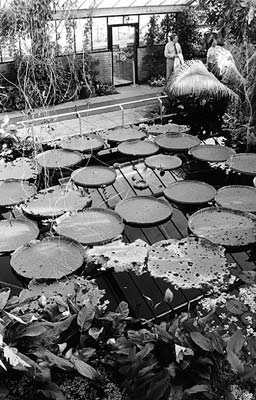
Cost and Hours: £16.50, June-Aug £11 after 16:00, kids 4-16-£3.50, kids under 4-free; April-Aug Mon-Fri 10:00-18:30, Sat-Sun 10:00-19:30, closes earlier Sept-March—check schedule online, glasshouses close at 17:30 in high season—earlier off-season, free one-hour walking tours daily at 11:00 and 13:30, Tube: Kew Gardens, boats run April-Oct between Kew Gardens and Westminster Pier—see here , tel. 020/8332-5000, recorded info tel. 020/8332-5655, www.kew.org .
Getting There: From the Tube station, cross the footbridge over the tracks, which drops you in a little community of plant-and-herb shops, a two-block walk from Victoria Gate (the main garden entrance).
Visiting the Gardens: Pick up a map brochure and check at the gate for a monthly listing of the best blooms. Garden lovers could spend days exploring Kew’s 300 acres. For a quick visit, spend a fragrant hour wandering through three buildings: the Palm House, a humid Victorian world of iron, glass, and tropical plants that was built in 1844; a Waterlily House that Monet would swim for; and the Princess of Wales Conservatory, a meandering modern greenhouse with many different climate zones growing countless cacti, bug-munching carnivorous plants, and more. With extra time, check out the Xstrata Treetop Walkway, a 200-yard-long scenic steel walkway that puts you high in the canopy 60 feet above the ground. Young kids will love the Climbers and Creepers indoor/outdoor playground and little zip line, as well as a slow and easy ride on the hop-on, hop-off Kew Explorer tram (adults-£4.50, kids-£1.50 for narrated 40-minute ride, departs Victoria Gate, ask for schedule when you enter).
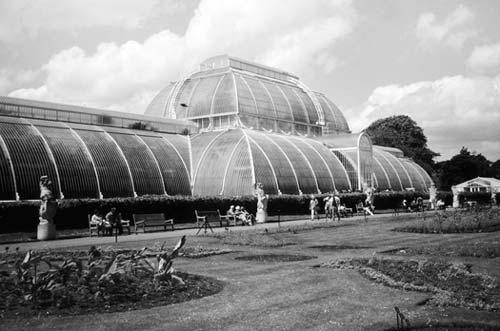
Eating: For a sun-dappled lunch or snack, walk 10 minutes from the Palm House to the $$ Orangery Cafeteria (Mon-Fri 10:00-17:30, Sat-Sun 10:00-18:30, until 15:15 in winter, closes early for events).
Fifteen miles up the Thames from downtown, the 500-year-old palace of Henry VIII is worth ▲▲ for palace aficionados. Actually, it was originally the palace of his minister, Cardinal Wolsey. When Wolsey, a clever man, realized Henry VIII was experiencing a little palace envy, he gave the mansion to his king. The Tudor palace was also home to Elizabeth I and Charles I. Sections were updated by Christopher Wren for William and Mary. The stately palace stands overlooking the Thames and includes some fine Tudor rooms, including a Great Hall with a magnificent hammer-beam ceiling. The industrial-strength Tudor kitchen was capable of keeping 600 schmoozing courtiers thoroughly—if not well—fed. The sculpted garden features a rare Tudor tennis court and a popular maze.
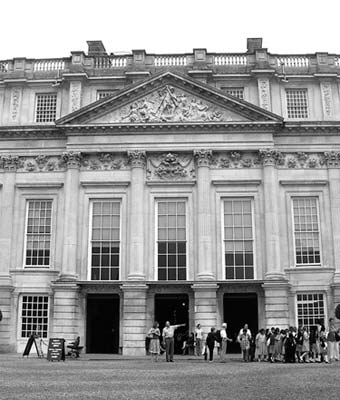
The palace tries hard to please, but it doesn’t quite sparkle. From the information center in the main courtyard, you can pick up audioguides for self-guided tours of various wings of the palace (free but slow, aimed mostly at school-age children). For more in-depth information, strike up a conversation with the costumed characters or docents posted in each room. The Tudor portions of the castle, including the rooms dedicated to the young Henry, are most interesting; the Georgian rooms are pretty dull. The maze in the nearby garden is a curiosity some find fun (maze free with palace ticket, otherwise £4.40).
Cost and Hours: £21, family-£51.70; online discounts, daily April-Oct 10:00-18:00, Nov-March until 16:30, last entry one hour before closing, café, tel. 0844-482-7777 or 020/3166-6000, www.hrp.org.uk .
Getting There: From London’s Waterloo Station, take a South West train. The train will drop you on the far side of the river from the palace—just walk across the bridge (2/hour, 35 minutes, Oyster cards OK). Consider arriving at or departing from the palace by boat (connections with London’s Westminster Pier, see here ); it’s a relaxing and scenic three- to four-hour cruise past two locks and a fun new/old riverside mix.
Kew Gardens/Hampton Court Blitz: Because these two sights are in the same general direction (about £20 for a taxi between the two), you can visit both in one day. Here’s a game plan: Start your morning at Hampton Court, tour the palace and garden, and have a Tudor-style lunch in the atmospheric dining hall. After lunch, take bus #R68 from Hampton Court Station to Richmond (40 minutes), then transfer to bus #65, which will drop you off at the Kew Gardens gate (5 minutes). After touring the gardens, have tea in the Orangery, then Tube or boat back to London.
A hit with aviation enthusiasts, this huge aerodrome and airfield contain planes from World War II’s Battle of Britain up through the Gulf War. You can climb inside some of the planes, try your luck in a cockpit, and fly with the Red Arrows in a flight simulator.
Cost and Hours: Free, £3 suggested donation, flight simulator-£3, daily 10:00-18:00, café, shop, parking-£3 for up to 3 hours, Grahame Park Way, 30-minute ride from downtown London plus another 15 minutes by foot, Tube: Colindale—top of Northern Line Edgware branch, tel. 020/8205-2266, www.rafmuseum.org.uk .
This surprisingly vast expanse of greenery sprawls over a square mile and a quarter at the northern edge of downtown London. It features rolling, scrubby pastures (“heath”) as well as tranquil wooded areas. Its most popular viewpoint, Parliament Hill, offers distant views of London’s fast-growing skyline. At the northeast corner of the park is a chunk of land owned by English Heritage, where a stately palace called Kenwood House overlooks a pasture, pond, and gentle wood; inside is a fine art collection, plus an inviting café (and WCs). Maps posted at each entrance to the park help get you oriented. On a sunny day, the park is crammed with Londoners communing with nature—relieved to escape from their bustling burg. The adjoining village of Hampstead is quaint and cute; a stroll through here is almost as pleasant as the park itself.
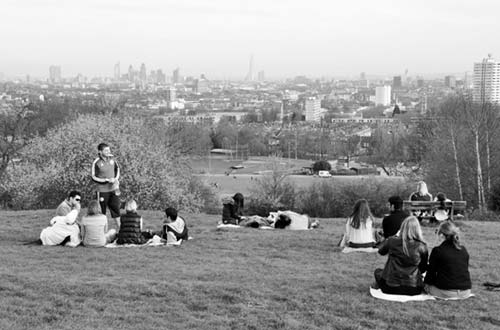
Getting There: Hampstead Heath is just a 20-minute Tube ride from downtown London. The handiest Tube stop is the one called Hampstead (on the convenient Northern line/Edgware branch, which runs north to south through London’s city center). This stop is in the middle of the charming village of Hampstead, from which it’s about a 10-minute walk to the park (turn left out of the station to head one block down Hampstead High Street, then turn left on Flask Walk—across from Starbucks—and follow it until it becomes Well Walk and eventually runs into East Heath Road; the park is in front of you, with Parliament Hill still a ways in and to the right). The station called Hampstead Heath, directly at the southern tip of the park and closer to Parliament Hill, is on the less convenient Overground line; however, bus #24 easily (though slowly) connects Victoria Station and downtown London (including Trafalgar Square) with the Hampstead Heath stop.
Hampstead Heath combines well with a visit to the fun and funky Camden Lock Market (see here ), which is on both the Northern Tube line and the bus #24 route.
Located in the tea-cozy-cute village of Highgate, north of the city, this Victorian cemetery represents a fascinating, offbeat piece of London history. Built as a private cemetery, this was the fashionable place to bury the wealthy dead in the late 1800s. It has themed mausoleums, professional mourners, and several high-profile residents in its East Cemetery, including Karl Marx, George Eliot, and Douglas Adams. The tomb of “Godfather of Punk” Malcolm McLaren (former manager of the Sex Pistols) is often covered with rotten veggies.
Cost and Hours: East Cemetery—£4, Mon-Fri 10:00-17:00, Sat-Sun 11:00-17:00; older, creepier West Cemetery—viewable by £12 guided tour only, price includes entrance to East Cemetery, Mon-Fri at 13:45—must book in advance; Sat-Sun 2/hour, 11:00-15:00, no reservations taken but space is limited; Tube: Archway on the Northern Line/High Barnet branch or—slower—bus #C2 from Victoria Station or Oxford Circus, tel. 020/8340-1834, www.highgatecemetery.org .
While you can visit several real-life locations in Britain where the Harry Potter movies were filmed (see sidebar on here ), there’s only one way to see imaginary places like Hogwarts’ Great Hall, Diagon Alley, Dumbledore’s office, and #4 Privet Drive: Visit the Warner Bros. Studio in Leavesden, where Daniel Radcliffe and company brought the tale of the boy wizard to life.
Attractions include the actual sets used for the films (Hogwarts bridge, Hagrid’s hut), several familiar costumes and props (such as the Nimbus 2000, the Sorting Hat, the Sword of Gryffindor, Hagrid’s motorcycle, and a Hogwarts Express attraction), video interviews with the actors and filmmakers, and exhibits about how the films’ special effects were created.
Your visit starts with an intro film and brief overview by a live guide. Then you’re free to wander through large halls with the sets, props, and costumes. You may be impressed by the level of detail the super-enthusiastic designers put into even the simplest of props. The visit culminates with a stroll down Diagon Alley and a room-sized 1:24-scale model of Hogwarts that will bring young Potter fans to tears.
As this attraction is understandably popular, it’s essential to reserve your visit online far in advance (entry possible only with reserved time slot). Allowing about three hours at the studio, plus nearly three hours to get there and back, this experience will eat up the better part of a day.
Cost and Hours: £35, kids ages 5 to 15-£27, family ticket for 2 adults and 2 kids-£107; opening hours flex with season—first tour at 9:00 or 10:00, last tour as early as 14:30 or as late as 18:30, if you miss your assigned entry time you’ll be admitted with the next group; audio/videoguide-£5, café, still photography allowed, tel. 0845-084-0900, www.wbstudiotour.co.uk .
Getting There: Leavesden is about 20 miles northwest of London. Reaching the studio is easy, requiring a train and shuttle bus connection. Give yourself at least 90 minutes to get from your central London hotel to the studio for your appointed time. First, take the frequent train from London Euston (platforms 8-11) to Watford Junction (about 5/hour, 20 minutes). At Watford Junction, exit the station and look left to find the bus stop. Catch the Mullany’s Coaches shuttle bus (instantly recognizable by its bright paint job) to the studio tour (2-4/hour, 15 minutes, £2 one-way, £2.50 round-trip, buy ticket from driver).
More direct (and more expensive), Golden Tours runs multiple daily buses between their office near Victoria Station and the studio (price includes round-trip bus and studio entrance: adults-£55-66, kids-£50-61; generally leaves London as early as 7:30, then throughout the day until around 16:00, tour begins 1.5-2 hours after bus departs, reserve ahead at www.goldentours.com ).